Dorsoduro is one of the six sestieri – or neighbourhoods – of Venice and coincidentally my favourite corner of Italy’s City of Canals.
Very underrated, Dorsoduro hosts several of Venice’s major landmarks and dozens of hidden gems that travel experts and connoisseurs of history and art know to seek out.
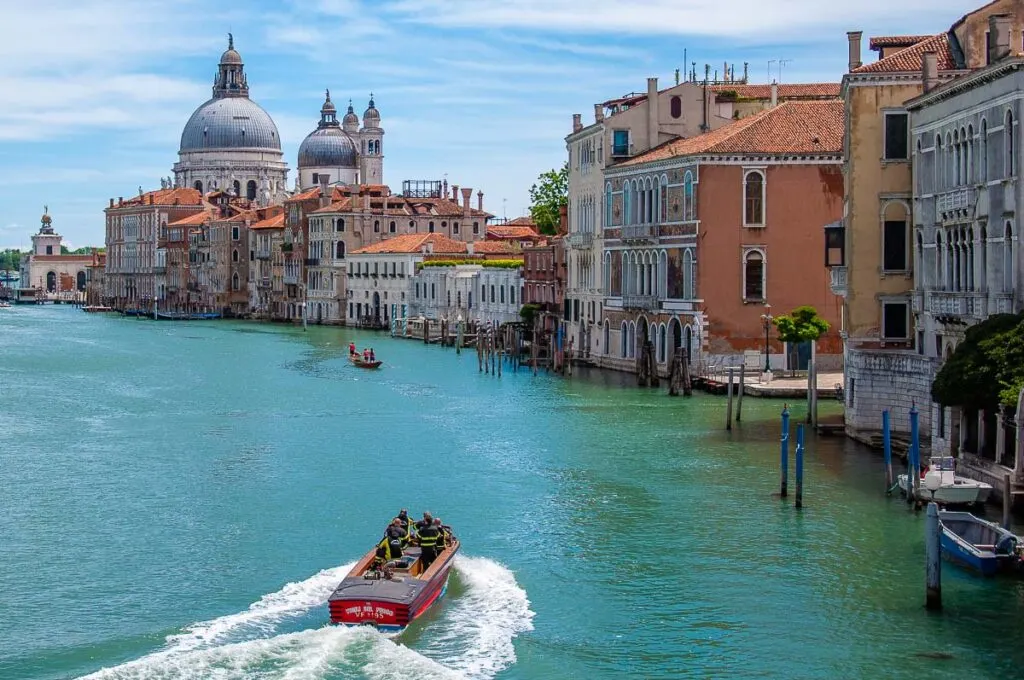
Dorsoduro is easy to reach on foot and by boat both from St. Mark’s Square and Venice’s railway station. The sestiere is the wide-based triangle at the southwestern end of the city. It borders the two most famous Venetian canals – Canale Grande and Canale della Giudecca. Administratively, it also includes the large island of Giudecca and the artificial island of Sacca Fisola with its modern residential buildings.
With a name that means ‘hard back’ or ‘hard ridge’ in Italian, Dorsoduro was originally an area of compact sand dunes. Its elevated ground was less marshy than the rest of the Venetian Lagoon. So, dwellings appeared here as early as the 6th century. By the Late Middle Ages, this was a lively neighbourhood of the City of Canals with churches, houses, and a large dock.
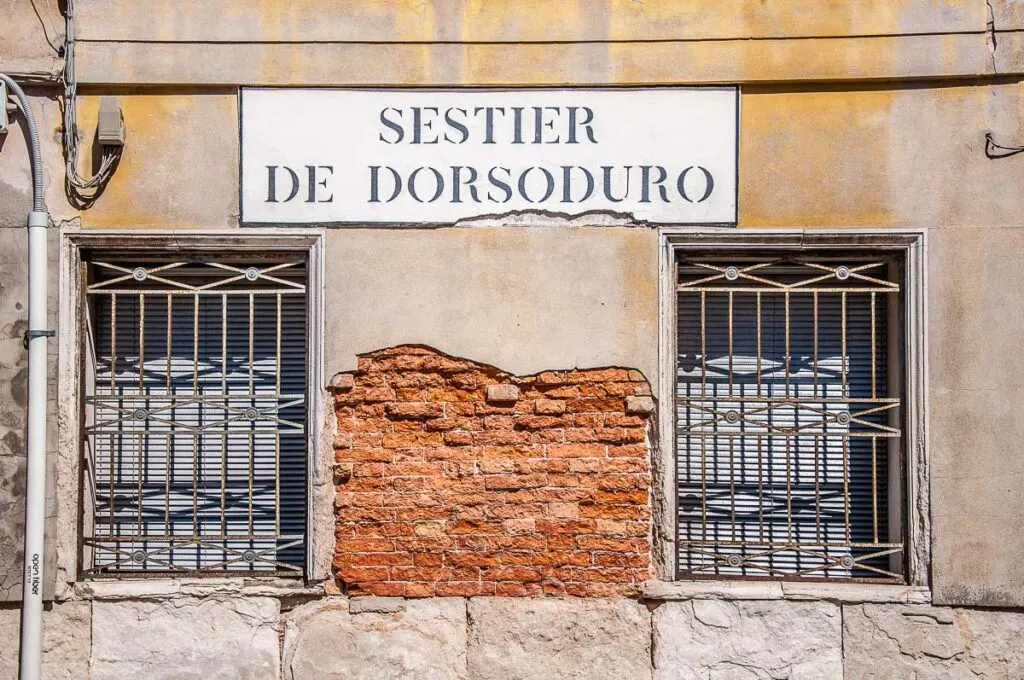
With all this history woven in its fabric, today Dorsoduro is a delight to explore. Here, a new surprise awaits around every corner. From art-filled churches and museums with priceless artefacts to quirky eateries serving Venetian delicacies, there is something for everyone to enjoy.
For example, Dorsoduro is where you will find the only spot in Venice that affords a panoramic view over the bridges of Rialto and Accademia on the Grand Canal, a patrician house showcasing the only painting by Botticelli in the City of Canals, and a cloister filled with stones and marbles from churches that are no more.
So, in this blog post today, I will share with you how to visit Dorsoduro and the best things to do here in order to enjoy a truly authentic Venetian experience.
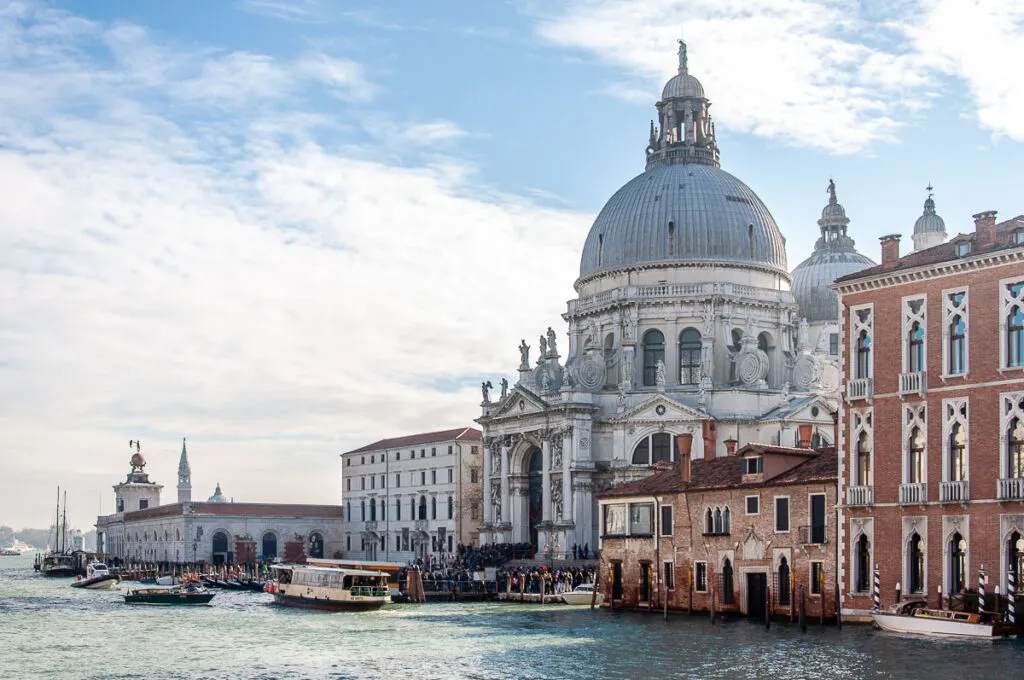
We will start by looking at the map to see where in Venice exactly is Dorsoduro. A second map then will show you the locations of the must-see landmarks in this underrated corner of the City of Canals. Next, a detailed list will cover the best things to do in Dorsoduro. For ease of browsing, the list is organised into the following alphabetised categories:
- Top Landmarks in Dorsoduro;
- Museums and Galleries in Dorsoduro;
- Churches in Dorsoduro;
- Sights and Places in Dorsoduro;
- Shops, Workshops, and Eateries in Dorsoduro; and
- Sights and Landmarks on the island of Giudecca.
Then, I will share with you an itinerary to help you see the best of Dorsoduro in one day. And at the end, you will find a practical section with travel tips about visiting this beautiful Venetian sestiere. From how to get to Dorsoduro on foot and by boat to where to stay here, everything is covered.
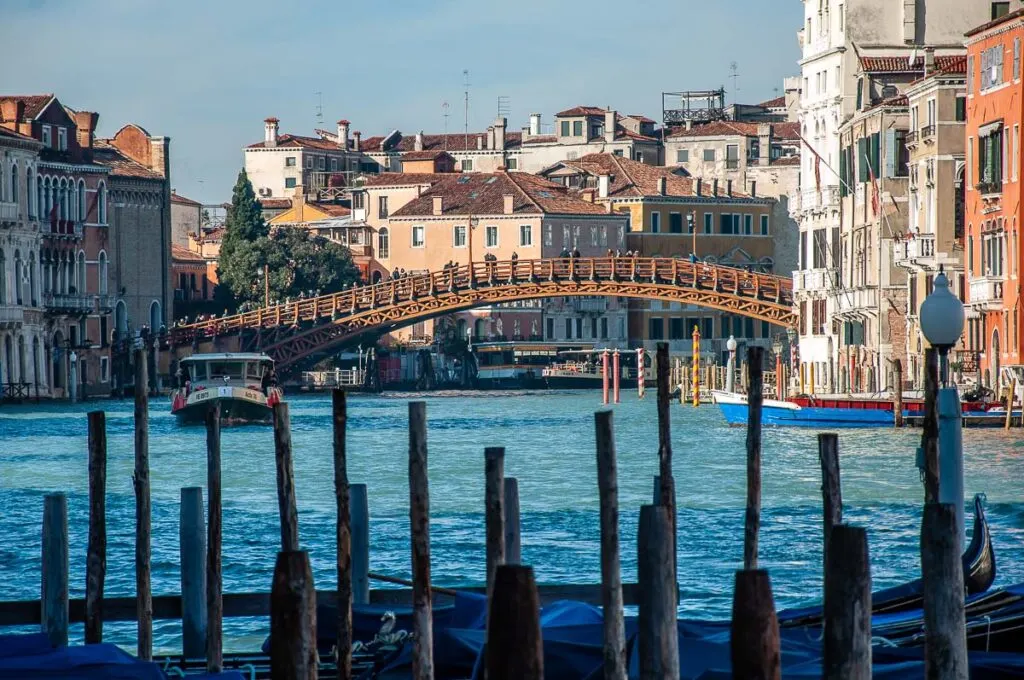
It’s a lot of information which I hope will come in very handy during the preparatory stages of your Venetian holiday. I trust that it will give you lots of ideas for things to do and see in Dorsoduro and that it will reveal to you many hidden gems in this underrated corner of Venice.
Have a look!
Where in Venice is Dorsoduro?
First things first! Let’s pinpoint on the map where in Venice is Dorsoduro.
With a name that means ‘hard back’ or ‘hard ridge’ in Italian, Dorsoduro was originally a series of small islands with sand dunes. Some of the first dwellings and churches in the Venetian Lagoon were built here in the Early Middle Ages. Then, the more Venice grew in size and power, the more tightly built-up Dorsoduro became and nowadays, it is one of Venice’s six neighbourhoods.
Historically, most Italian cities used to be divided into four quarters (in Italian, quertiere) or districts. Unlike them, Venice is organised in six districts called sestiere (pl. sestieri). They are Cannaregio, Santa Croce, San Polo, Dorsoduro, Castello, and San Marco. Three of them are on the left-hand side of the Grand Canal and three are on the right-hand side.
Dorsoduro runs along the southwestern edge of the City of Canals and borders the sestieri of Santa Croce and San Polo. Across the Grand Canal, it faces the sestiere of San Marco. Across the Giudecca Canal, it faces the long thin island of Giudecca and the adjacent island of Sacca Fisola. Administratively, both are also part of Dorsoduro.
The above map shows the exact location of Dorsoduro in Venice. The sestiere is outlined in red and you can see how close it is to San Marco – the Venetian sestiere where you can visit the iconic St. Mark’s Square, St. Mark’s Basilica, and the Doge’s Palace. You can reach Dorsoduro from St. Mark’s Square in about 10-15 mins either on foot across the Accademia Bridge or by taking a traghetto across the Grand Canal. Further below, I have explained in detail how to do this.
The map doesn’t outline the islands of Giudecca and Sacca Fisola with red (even though, administratively, they are part of Dorsoduro). However, you can get a good idea of their position on the opposite side of the Giudecca Canal.
You can zoom in and out to get a better idea of the location of Dorsoduro in Venice. You can also use this map to calculate directions from specific points of departure in the City of Canals to the sights you want to visit in Dorsoduro. If you wish, you can also open a larger version of this map in a new tab to make it easier to browse.
Map of the Best Things to Do in Dorsoduro in Venice, Italy
Here is a useful map showing the exact location of the best sights and landmarks to visit in the Venetian sestiere of Dorsoduro. You can zoom in and out to get a better visual idea of how close they are to one another and to other points of interest in Venice.
You can also use this map to calculate specific directions from one sight to another. If you click on the grey star next to the map’s name, this will add the map to your account in Google Maps. This way, you can consult it as and when you want.
Here are the sights and landmarks pinned to this map of Dorsoduro in Venice. Click on their respective icons on the map to find their exact address. Click on the links below to access either the official website (where available) or a ticket-selling portal for the different sights:
Top Landmarks in Dorsoduro, Venice – Gallerie dell’Accademia – Accademia Bridge – Basilica di Santa Maria della Salute – Ca’ Rezzonico – Peggy Guggenheim Collection – Fondamenta delle Zattere
Museums and Galleries in Dorsoduro, Venice – Palazzo Cini – Pinacoteca Manfrediniana – Punta della Dogana (Pinault Collection) – Scuola Grande dei Carmini
Churches in Dorsoduro, Venice – Church of San Nicolo’ dei Mendicoli – Church of Santa Maria dei Carmini – Church of Santa Maria del Rosario (Gesuati) – Church of San Pantalon – Church of San Sebastiano – St. George’s Anglican Church
Sights and Places in Dorsoduro, Venice – Banksy’s Mural The Migrant Child – Ca’ Dario – Ca’ Foscari University of Venice – Campo San Barnaba – Campo Santa Margherita – Magazzini del Sale – Palazzo Barbarigo – Palazzo Salviati – Ponte dei Pugni – Traghetto Station Santa Maria del Giglio
Shops, Workshops, and Eateries in Dorsoduro, Venice – Ca’ Macana – Nico Gelateria – Osteria Al Squero – Signor Blum – Squero di San Trovaso – Squero Tramontin – Vegetable Barge Barca di San Barnaba
Sights and Landmarks on the Island of Giudecca, Venice – Cantiere Nautico Crea – Casa dei Tre Oci – Church of Santa Maria della Presentazione (Le Zitelle) – Church of the Santissimo Redentore – Hilton Molino Stucky
35 Best Things to Do in Dorsoduro in Venice, Italy
Pin for Later!
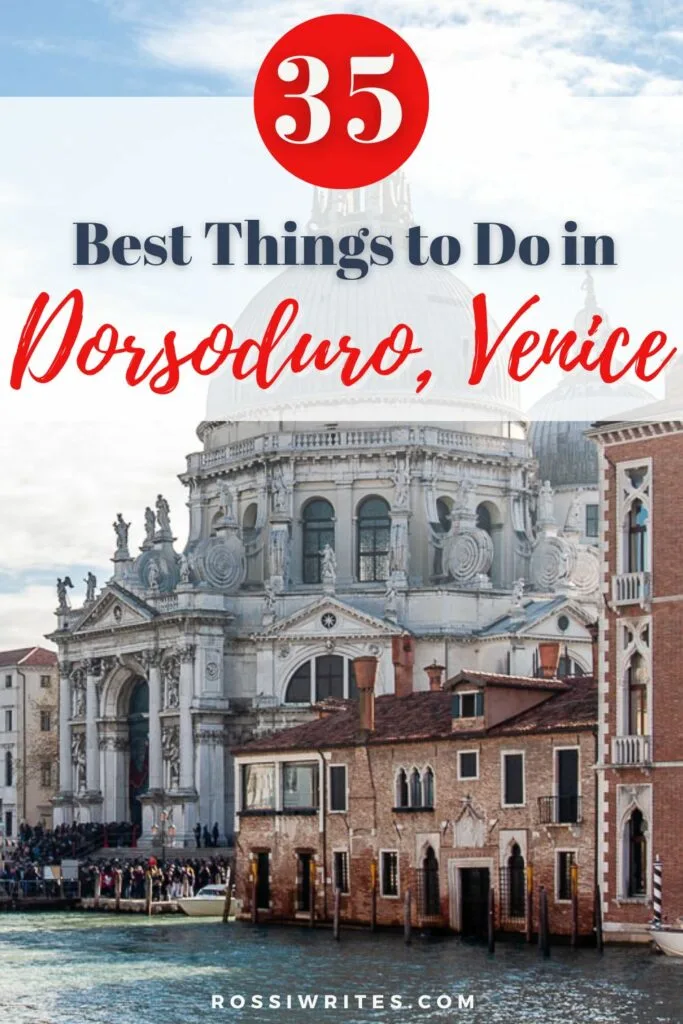
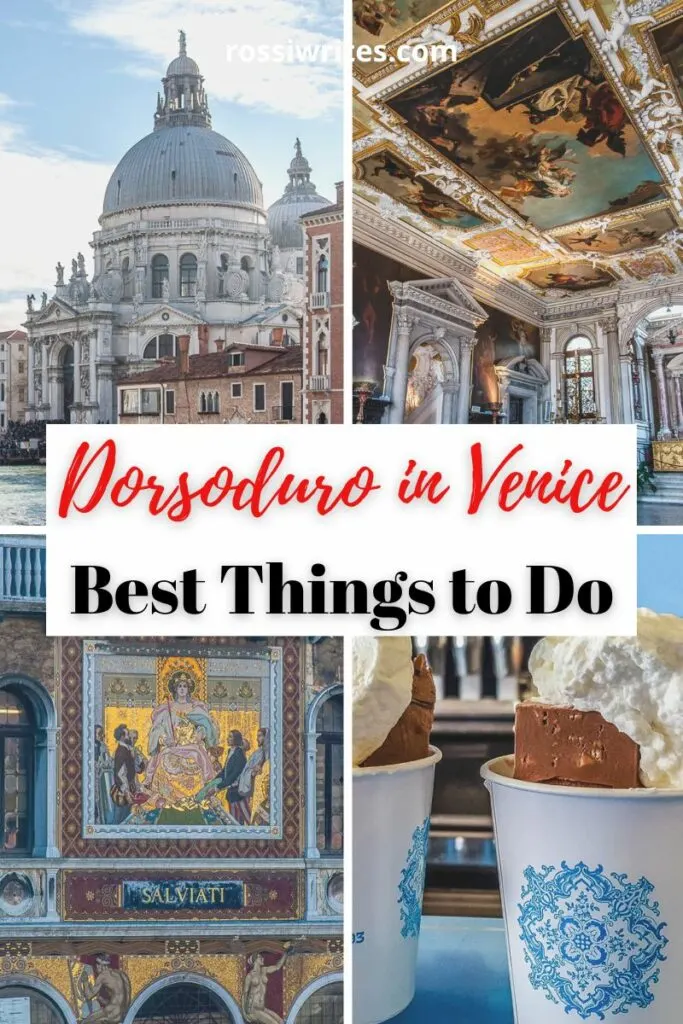
I. Top Landmarks in Dorsoduro in Venice, Italy
The sestiere of Dorsoduro hosts some of Venice’s most well-known landmarks. The Basilica della Salute, for example, features in thousands of iconic photos of the City of Canals. The Gallerie dell’Accademia, on the other hand, is where you can see the world’s largest collection of Venetian art – from the Late Middle Ages through the Renaissance and up to the beginning of the 19th century.
So, sightseeing in Dorsoduro is exciting and rewarding on many different levels. No matter what your main interest may be – art, photography, history or even keeping fit through walking – in Dorsoduro you will find something that appeals personally to you.
Even if you are in Venice for a short amount of time, make sure that you explore Dorsoduro. These top landmarks are a must-see here.
1. Gallerie dell’Accademia and Accademia Bridge
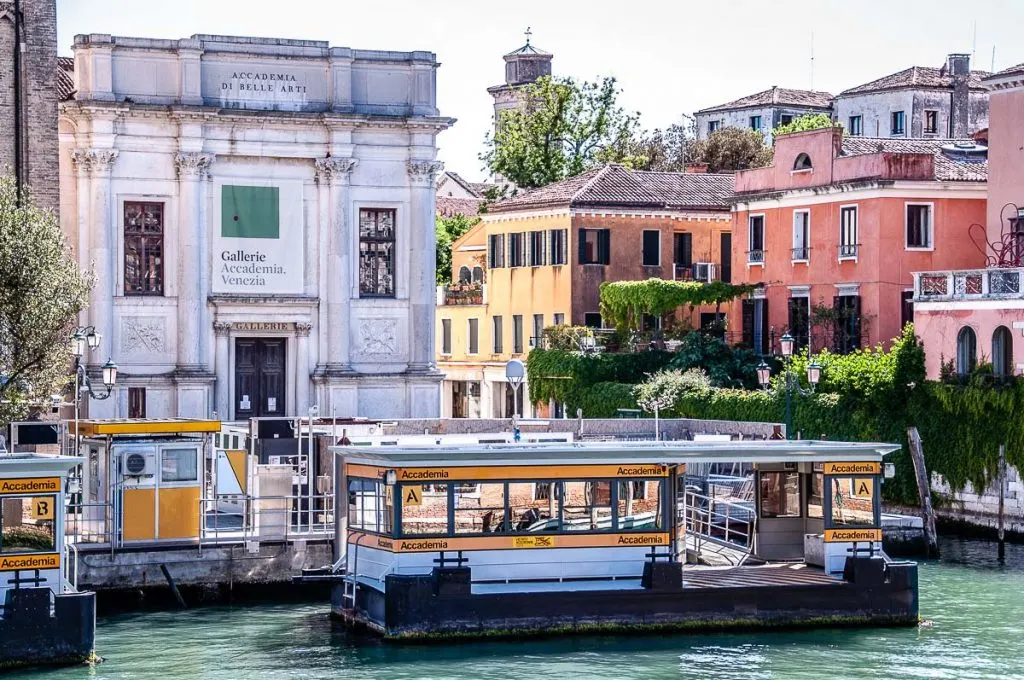
The Gallerie dell’Accademia is a large art gallery showcasing the best of Venetian art between the 14th and the early 19th centuries. Here you can admire famous paintings by the best artists of the Venetian School. Among them are Giovanni Bellini, Andrea Mantegna, Titian, Giorgione, Tintoretto, and Paolo Veronese.
Walking through the 37 halls of the Gallerie dell’Accademia, you feel like you are in a book on the history of art. Paintings that we usually see on the pages of books – from Byzantine-inspired depictions to Baroque masterpieces – here stand in front of you in all their splendour.
Curiously, Leonardo da Vinci’s Vitruvian Man is also kept here. To the disappointment of many, this famous drawing is not on permanent display. Due to its fragile nature, the Gallerie dell’Accademia show it to the general public only on special occasions. The last time was in 2019.
Standing right in front of the Gallerie dell’Accademia, the Accademia Bridge is one of the only four bridges that span the Grand Canal in Venice. The bridge connects the sestiere of Dorsoduro to the sestiere of San Marco. It affords the most iconic view of the City of Water – that of the southern end of the Grand Canal with the Basilica della Salute dominating the background.
The Accademia Bridge was built over 37 days in 1933. At the time, it was the largest wooden arch bridge in Europe.
For more details about both the Gallerie dell’Accademia and the Accademia Bridge in Dorsoduro, Venice have a look at points 8 and 9 in this blog post:
2. Basilica di Santa Maria della Salute

Commonly known as the Basilica della Salute, this is one of the most famous churches in Venice. It stands on the southern end of the Grand Canal and dates back to the 17th century. It was erected as a votive offering to the Virgin Mary after a devastating bout of the plague slaughtered nearly one-third of all Venetians between 1630 and 1631.
The Basilica della Salute was designed by the architect Baldassare Longhena. 26 years old at the time, he won the competition that had been announced for the construction of the new church. There were eleven submissions and Longhena’s vision of a round, crown-shaped sacred building led to the creation of one of the most beautiful Baroque churches in Europe.
The Basilica della Salute features in many iconic images of Venice. You can enjoy a beautiful panorama of it standing on the Accademia Bridge. A visit is a must for its history, architectural beauty, facade ornate with sculptures, and many works of art.
For more details about the Basilica della Salute in Dorsoduro, Venice have a look at point 10 in this blog post:
3. Ca’ Rezzonico
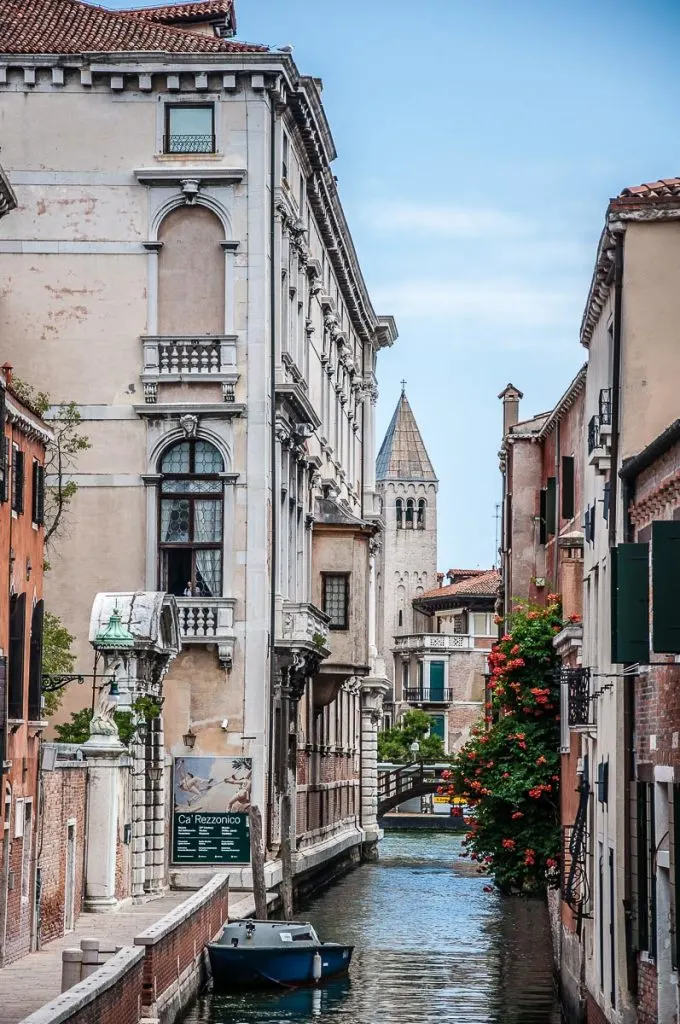
Ca’ Rezzonico is a must-see in Dorsoduro if you have a specific interest in the art and culture of 18th-century Venice. This lavish palazzo on the Grand Canal is entirely dedicated to the last century of existence of the Republic of Venice. It hosts an extraordinary collection of paintings, art objects, Murano glass chandeliers, and even a whole historic pharmacy shop.
A special mention here deserve the paintings by the artist Pietro Longhi. They show scenes of Venetian life in a realistic, almost photographic style.
Also in Ca’ Rezzonico, you can see the famous series of Carnival frescoes by Giandomenico Tiepolo. They depict Punchinello (known as Pulcinella in Italian) – one of the most popular characters of Commedia dell’Arte.
In the past, these frescoes adorned the villa where the painter’s family lived in the small village of Zianigo on the Venetian mainland. They were transferred to Ca’ Rezzonico in 1936 after the city of Venice purchased them to prevent them from being sold abroad.
4. Peggy Guggenheim Collection
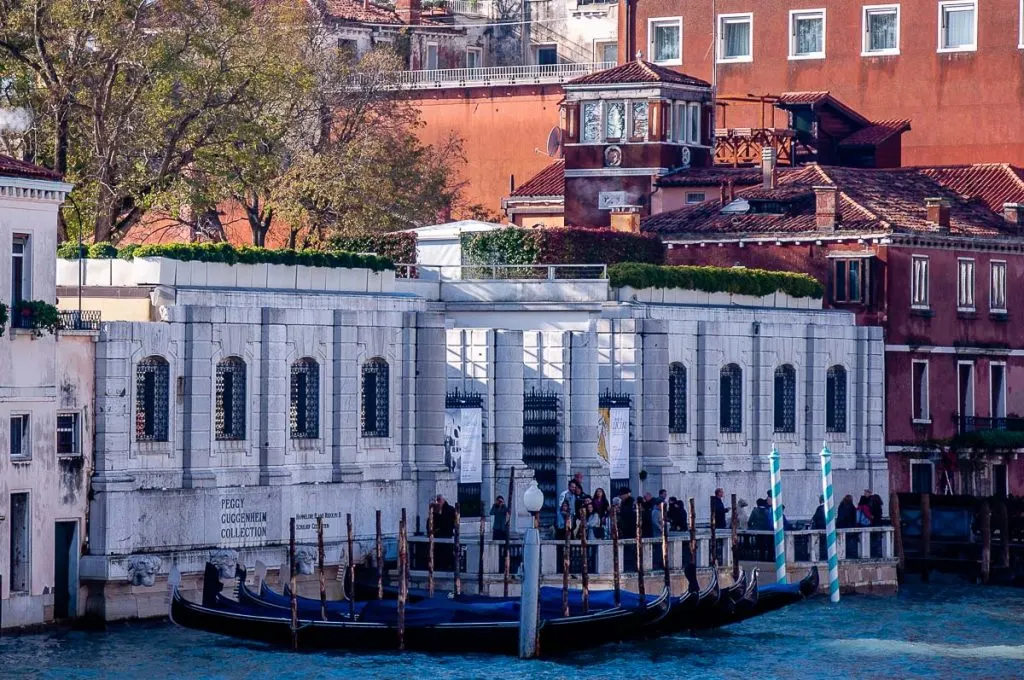
The Peggy Guggenheim Collection is one of Dorsoduro’s most famous landmarks. It’s a must-see, especially, if you have an interest in the European and American art of the 20th century.
Alternatively, come here if you have spent a few days in Venice and you are starting to feel a bit overwhelmed by all the Venetian Gothic, Renaissance, and Baroque art. The abstract world of the paintings, sculptures, and installations displayed here offers a rather stark contrast to the rest of Venice.
The larger-than-life figure of Peggy Guggenheim – a mecenate and a woman who knew how to elevate life to an art form – permeates the many rooms of this art gallery housed in the 18th-century Palazzo Venier dei Leoni. Her ashes are interred next to her beloved dogs in the palazzo’s garden.
The Peggy Guggenheim Collection exhibits many masterpieces of modern art, has a sculpture garden, organises acclaimed events, and even holds a free art workshop for children every Sunday. Even if modern art is not your cup of tea, it is a wonderful and whimsical place to visit in the Venetian sestiere of Dorsoduro. Not least for the great views of the Grand Canal and The Angel of the City sculpture revelling in ecstasy at the best viewpoint.
5. Fondamenta delle Zattere
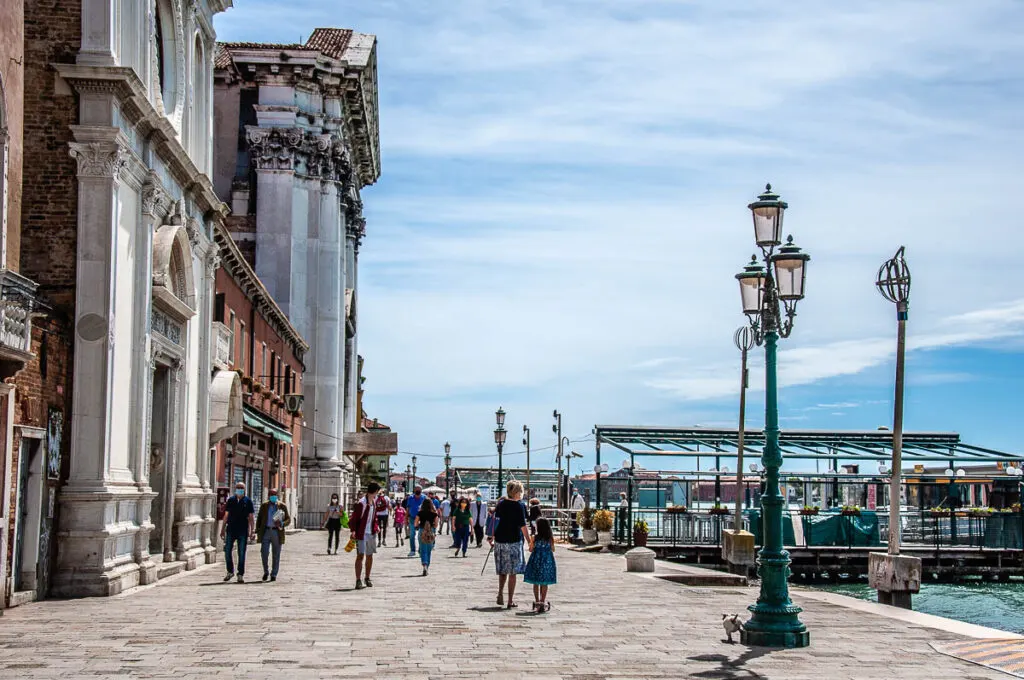
The Fondamenta delle Zattere is a long waterfront promenade. It brims the southern bank of Dorsoduro and it opens splendid views over the Giudecca Canal and the island of Giudecca. Venetians love coming here for a leisurely walk with far-reaching panoramas across the water.
The fondamenta is named after the zattere which centuries ago would dock here. These were the rafts loaded with wooden logs from the forests and mountains of northeastern Italy. They were then used for the construction of the foundations of the Venetian palaces and buildings.
The fondamenta runs along 1,7 km from San Basilio vaporetto stop to the Punta della Dogana. I would suggest walking it either early in the morning or late in the afternoon. There is not much shade along the way and on a summer day, it can get swelteringly hot here.
If you want to find out more details about the fondamente of Venice and the many other typically Venetian place names, have a look at this blog post:
II. Must-See Museums and Galleries in Dorsoduro in Venice, Italy
Apart from Gallerie dell Accademia and Ca’ Rezzonico, in Dorsoduro, you will find several other museums and art galleries. Below is a short list of the most interesting ones.
One of them, for example, hosts the only painting by Botticelli in Venice. Another is where you can see a priceless collection of archaeological artefacts from the Venetian churches that were demolished after Napoleon suppressed the religious orders in Northern Italy at the start of the 19th century.
Off the beaten track and customarily overlooked by the tourist crowds, these museums and art galleries in Dorsoduro are a delight to explore if you want to experience Venice on a deeper level.
1. Palazzo Cini
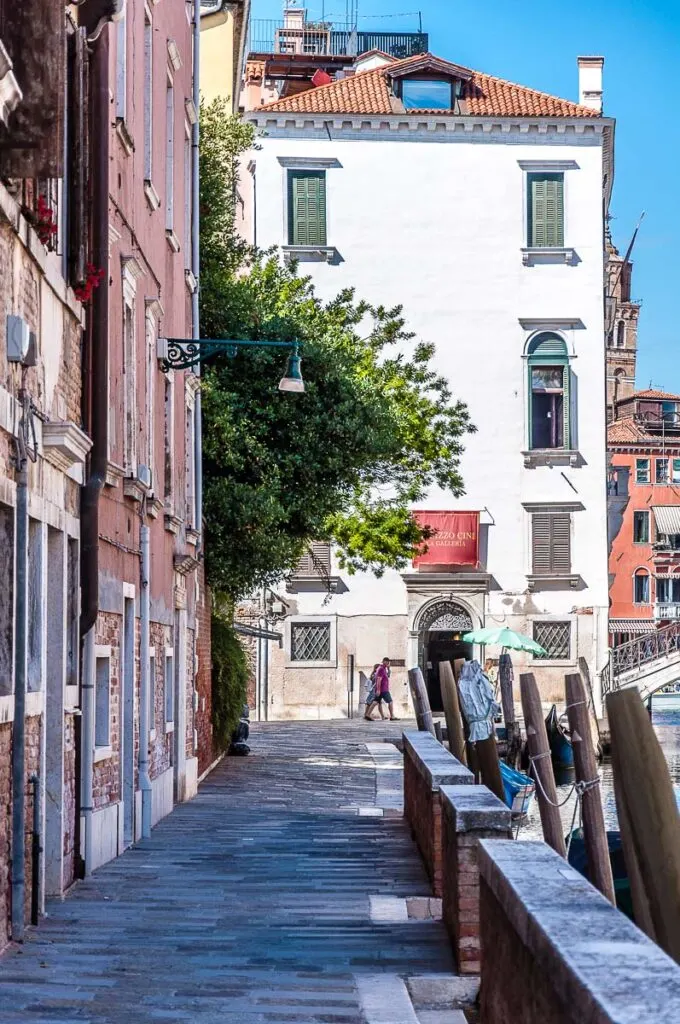
Palazzo Cini in Dorsoduro is one of Venice’s true hidden gems. Inside it, you will find a refined museum based on the historic art collection of Vittorio Cini – a 20th-century industrialist, politician, and one of Italy’s richest men.
The museum has two floors and a lovely spiral staircase connecting them to the ground foyer. The second floor is where some of the most exciting temporary exhibitions in Venice take place.
The first floor of the museum recreates Cini’s residence. Expect a series of small rooms covered with lavish fabrics and dotted with pieces of furniture made of prized woods. Among them are positioned the stars of the collection – Tuscan paintings, sculptures, and art objects dating back to the 13th-16th centuries.
The most unexpected discovery here is the painting ‘The Judgement of Paris’ by the famous Florentine artist Sandro Botticelli. It’s the only work by Botticelli in Venice and this in itself is a good enough reason to visit Palazzo Cini.
2. Pinacoteca Manfrediniana and Diocesan Museum of the Patriarchate of Venice
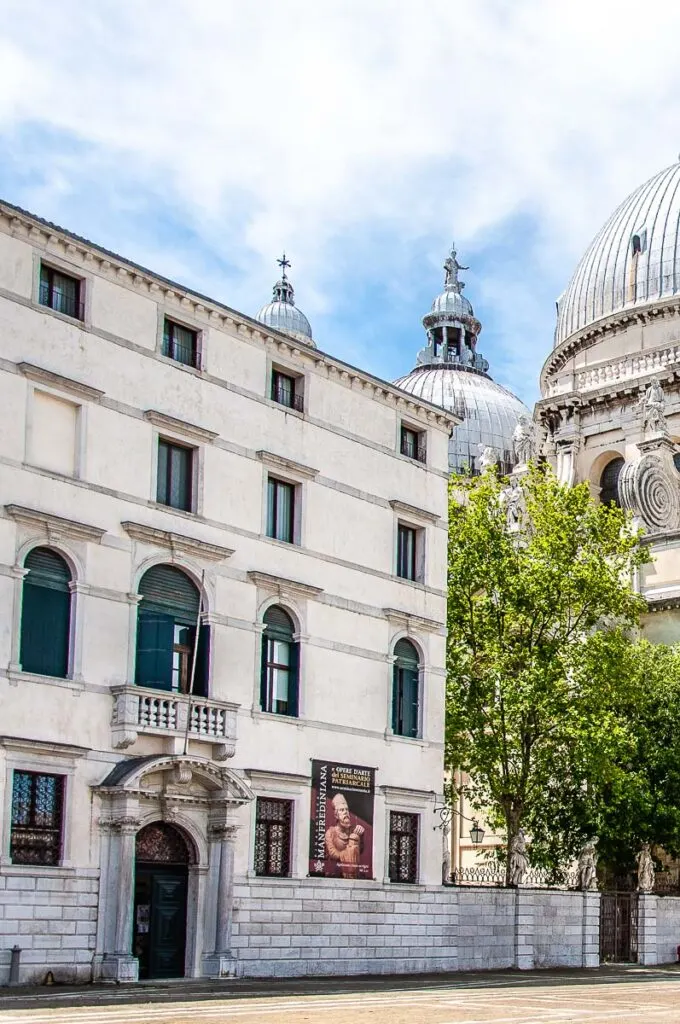
The Pinacoteca Manfrediniana is an art gallery in Dorsoduro that showcases the collection of Federico Manfredini – an 18th-century marquis. Since 2019, it also functions as the Diocesan Museum of the Patriarchate of Venice and it’s been enriched with many new works of art.
Come here to see masterpieces by famous Venetian painters and sculptors such as Vivarini, Bellini, Cima da Conegliano, and Alessandro Vittoria. There are also works of art from Central Italy and Northern Europe.
The pinacoteca is housed in the Patriarchal Seminary of Venice. Its building stands right between the Basilica della Salute and the Punta della Dogana. It was originally designed as a monastery by Baldassare Longhena who was also the architect of the Basilica della Salute.
A visit to the pinacoteca will also give you access to the Seminary’s cloister. Here you can see ancient artefacts saved from various Venetian churches that were destroyed after Napoleon’s suppression of the religious orders in Italy at the start of the 19th century.
3. Punta della Dogana – Pinault Collection
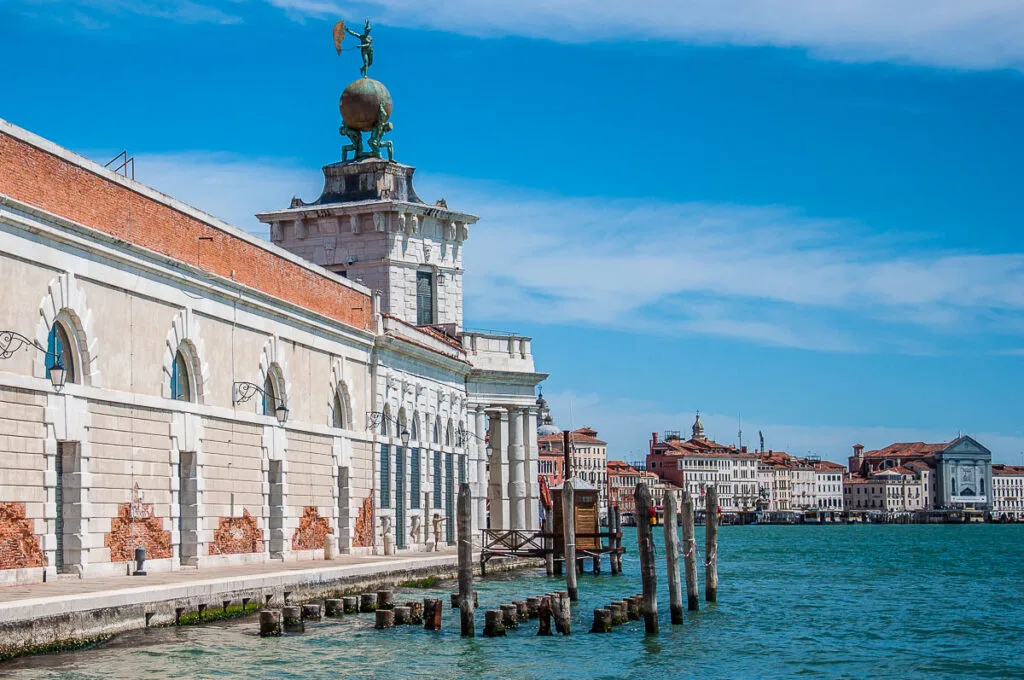
Punta della Dogana is an iconic triangular piece of land in Venice. At its tip, the Grand Canal meets the Giudecca Canal as they flow into the blue expanse of the Basin of St. Mark.
Venice’s former Sea Customs House (Dogana da Mar) stands on Punta della Dogana. Its triangular building dates back to the 17th century when it was used to perform tax checks on the merchant ships that brought a constant flow of goods to Venice from all around the Mediterranean Sea and further beyond.
Nowadays and after extensive restoration work, the building functions as an art museum under the name Punta della Dogana. It’s part of the network of sites and initiatives curated by the Pinault Collection. Large-scale temporary art events and exhibitions are held here.
Punta della Dogana – both the triangular piece of land and the former customs house – are always a great destination to visit in Dorsoduro. It affords beautiful views over some of Venice’s most iconic buildings and it’s right next door to some of the best landmarks to see for yourself in the City of Canals.
4. Scuola Grande dei Carmini
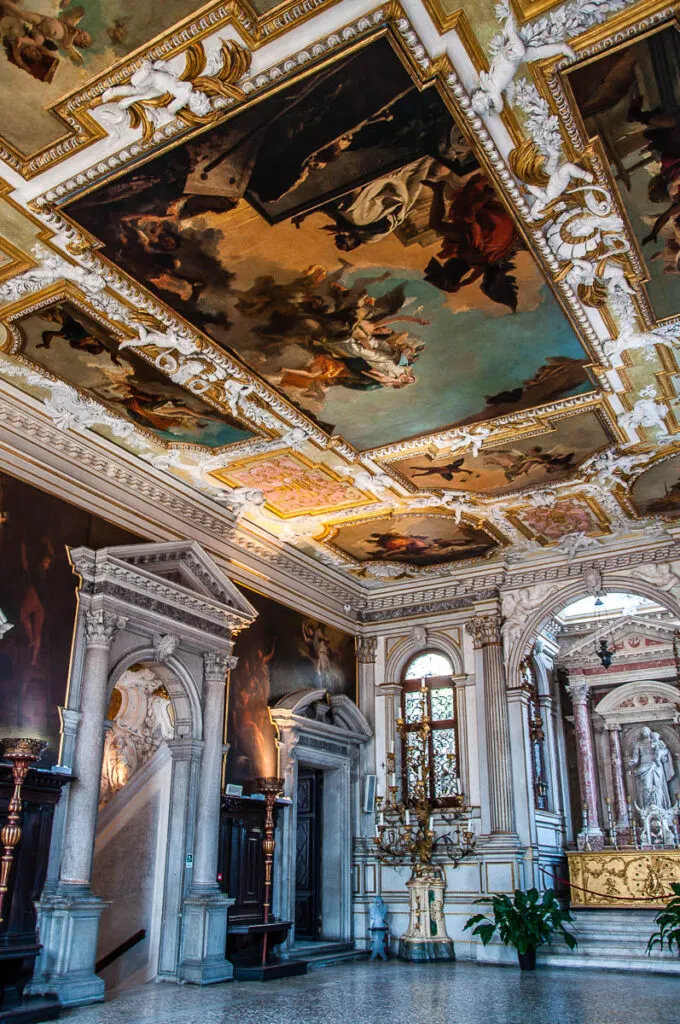
The Scuola Grande dei Carmini was the seat of one of the confraternities or Scuole Grandi that functioned in Venice between the 13th and the 18th centuries. With a name that means ‘Great School’ in English, they were made of rich Venetian citizens who dedicated time and resources to charitable and religious projects.
In total, there were seven Great Schools in Venice. Founded in 1594, the Scuola Grande dei Carmini was the last Venetian Scuola to be elevated to a Scuola Grande. This happened in 1767 – only 30 years before the Fall of the Republic of Venice.
You will find the building of the Scuola Grande dei Carmini right next to the Church of Santa Maria dei Carmini in Dorsoduro in Venice. Inside, it’s richly decorated with stuccoes, frescoes, and wooden wall coverings. Particularly famous are the canvasses by the renowned Rococo artist Giambattista Tiepolo on the ceiling of the Capitular Hall.
Most visitors of Venice flock to the more well-known Scuola Grande di San Rocco in the adjacent sestiere of San Polo. Yet, the Scuola Grande dei Carmini is a beautiful and intriguing place where you can enjoy in peace many splendid works of art.
III. Must-See Churches in Dorsoduro in Venice, Italy
The Venetian sestiere of Dorsoduro is dotted with some of the most important and intriguing churches – in terms of history and art – in the City of Canals. Chief among them is the iconic Basilica della Salute (covered in detail above) which features in many of the most emblematic photos of Venice.
In addition to it, don’t miss the following smaller yet beautiful churches in Dorsoduro. Even if you only have a day to explore this underrated corner of Venice, make sure that you see at least the Church of San Pantalon and the Church of San Sebastiano.
Your best course of action, not just for Dorsoduro, but for the whole of Venice, is to enter every church that you come across here (irrespective if it’s on the list below or not). Each one of them hides an invaluable collection of art and has centuries-old stories to tell.
Another tip is to look into purchasing a Chorus Pass in advance. Chorus is an association working for the preservation of several historic churches in Venice. The pass gives you access to 15 of the most beautiful churches in the City of Canals. Several of them are in the sestiere of Dorsoduro.
1. Church of San Nicolo’ dei Mendicoli
The Church of San Nicolo’ dei Mendicoli has beautiful colonnades and pictorial decorations. More interestingly though, it stands in the parish of Mendigola – once a small island which was one of the first spots to be inhabited in Venice. A church has existed here since the 7th century and some say that before that an ancient temple was positioned here.
The current church dates back to the 16th century although it preserves its 12th-century plan and large portions of a late medieval fresco. Even more curiously, this is the church that John Baxter (played by the famous actor Donald Sutherland) restores in the iconic Venice-based film Don’t Look Now.
2. Church of Santa Maria dei Carmini
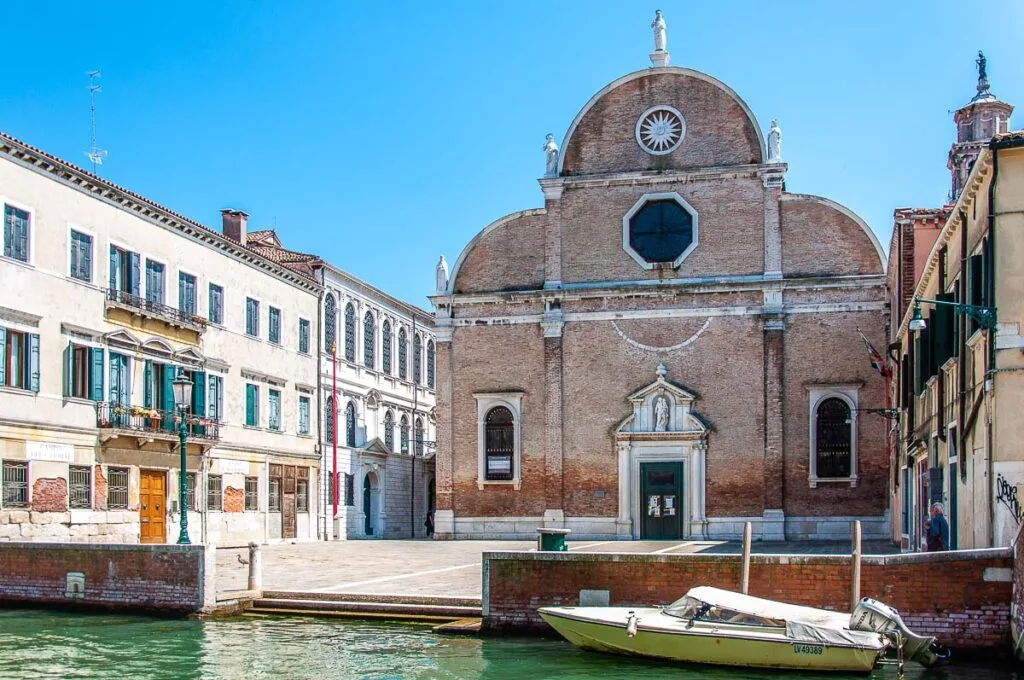
Founded at the end of the 13th century, the Church of Santa Maria dei Carmini stands right next door to the Scuola Grande dei Carmini. Its brick facade is in the early Venetian Renaissance style. The interior preserves its Gothic shape and it’s where you can admire masterpieces by Cima da Conegliano, Lorenzo Lotto, and Tintoretto among many others.
The church is looked after by Chorus.
3. Church of Santa Maria del Rosario (Gesuati)

The Church of Santa Maria del Rosario is an imposing 18th-century church that stands on the Fondamenta delle Zattere and faces the Giudecca Canal. It was built by the Dominican order but it’s most commonly known as Gesuati after the Poor Gesuati. This was a religious order that existed between the 14th and the 17th centuries and originally owned the land on which the church stands.
The facade and the interiors of the Church of Gesuati were inspired by the Palladian Church of the Santissimo Redentore which can be seen on the opposite bank of the Giudecca Canal. Inside, you can admire 40 celebrated frescoes by Giambattista Tiepolo – the greatest Italian painter in the Rococo style.
The church is looked after by Chorus.
4. Church of San Pantalon
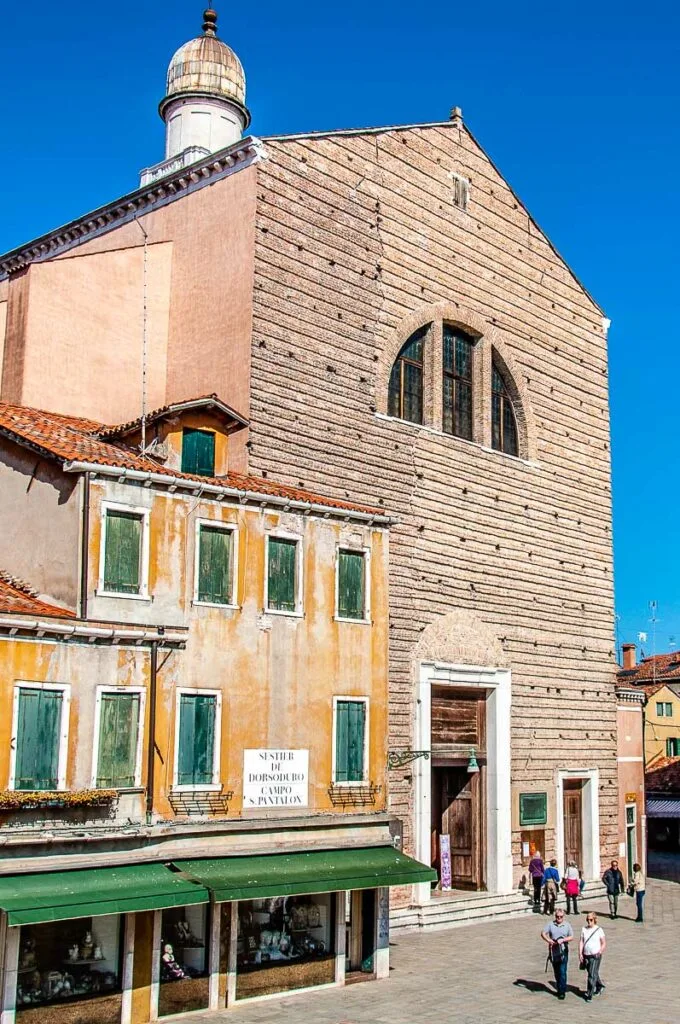
The Church of San Pantaleone Martire (known as San Pantalon in the Venetian language) is one of Venice’s most precious hidden gems. Its plain brick facade doesn’t prepare you for the masterpieces kept inside.
The most impressive of them all is the enormous painting covering the church’s whole ceiling. Depicting The Martyrdom and Apotheosis of St. Pantalon, it was painted by Gian Antonio Fumiani over a period of 20 years. It is considered to be the world’s largest painting on canvas. To get a proper look at it, put a coin in the donation box by the pews. This will illuminate the ceiling bringing in sharp focus the hundreds of figures that populate it.
In the Church of San Pantalon, you can also admire the wonderful Madonna of the Poppy by the Byzantine- and Gothic-inspired painter Paolo Veneziano. A side chapel has frescoes by Pietro Longhi – a famous Baroque painter with a photographic eye. Finally, the church’s Capella del Sacro Chiodo is a chapel where a nail from the Crucifixion of Jesus is kept as a holy relic.
5. Church of San Sebastiano
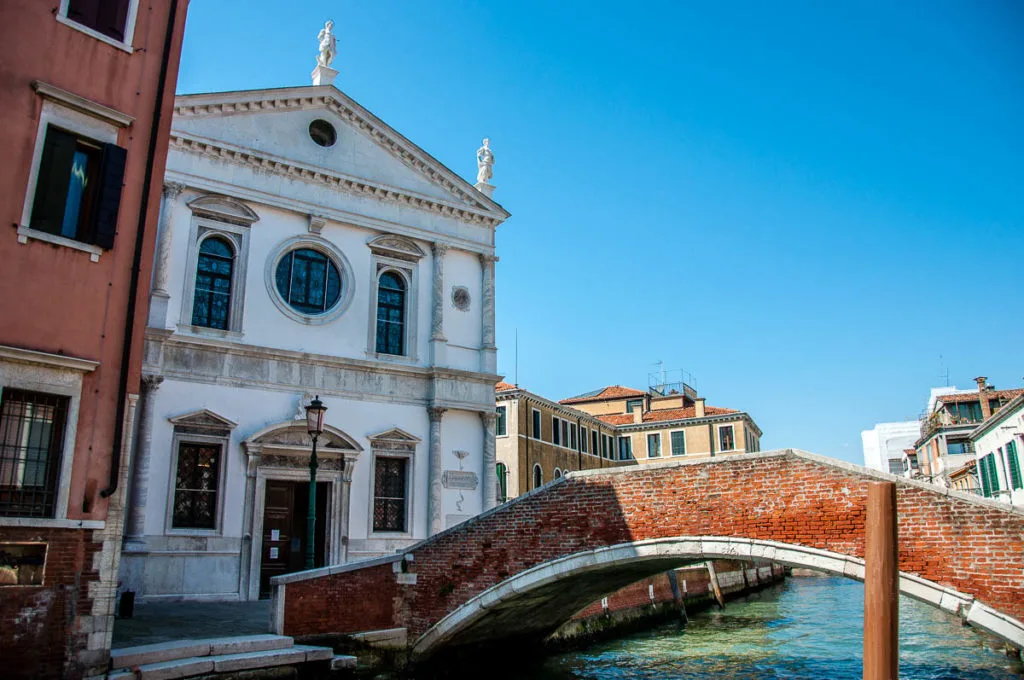
The Church of San Sebastiano dates back to the 16th century. It has a rather plain facade and it stands firmly off the beaten track. Yet, it’s known to lovers of art all over the world who reverentially call it the Veronese Church.
For it is here that you can see the most important pictorial cycle by the famous Renaissance artist Paolo Caliari – better known as Veronese. The artist himself is also laid to rest here.
The church was built as a votive offering after a devastating bout of the plague hit Venice. As such, it is one of five Plague Churches in the City of Water. The other ones are the Basilica della Salute (also in Dorsoduro), the Church of the Santissimo Redentore (on the island of Giudecca), the Church of San Rocco (in the sestiere of San Polo), and the Church of San Giobbe (in the sestiere of Cannaregio).
The Church of San Sebastiano is looked after by Chorus.
6. St. George’s Anglican Church
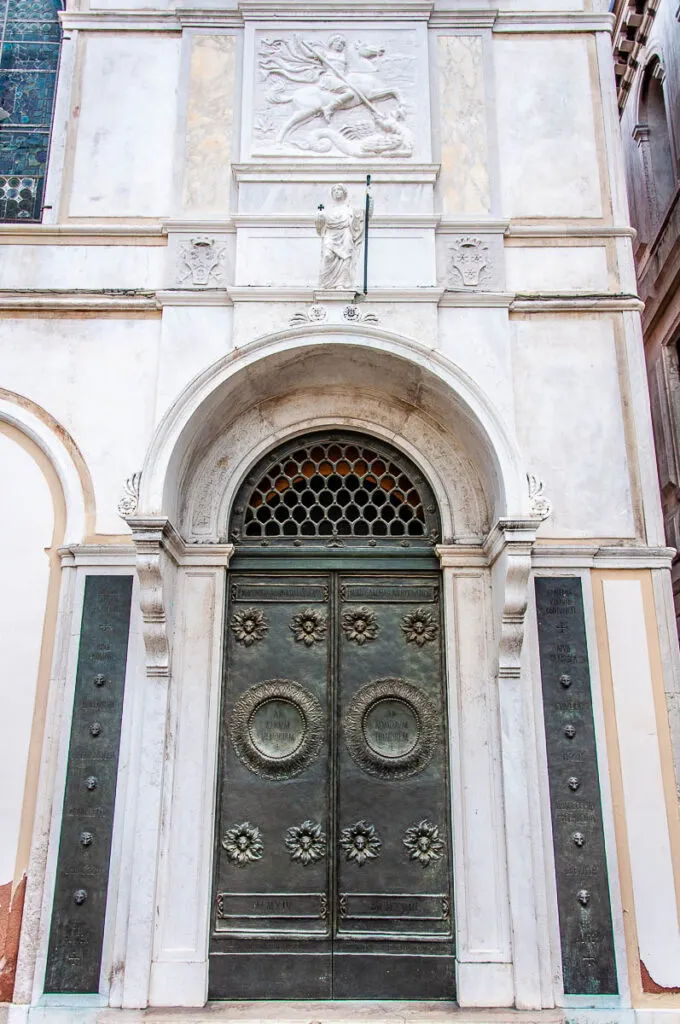
St. George’s Church is the church of the Anglican community in Venice. You will find it just across a small square from Palazzo Cini. Its long rectangular body started life as a warehouse of the Venezia-Murano Glass and Mosaic Company. Curiously, the company was founded by the Salviati family of glass-makers and mosaic artists. Their works grace such worldwide-famous landmarks as the House of Parliament and the Albert Memorial in London and the Paris Opera House.
The former warehouse was purchased in 1889 to serve as the English church in Venice. It was dedicated in 1892. Nowadays, St. George’s Church holds Sunday services with organ music, hymns, and sermon for the English-speaking community – both permanent residents and visitors – of the City of Canals. The church is also often used as a venue where art exhibitions and music concerts are staged.
As you walk past St. George’s Church, you will recognise it by the fine bas-relief of St. George and the dragon which stands above a pair of monumental bronze doors.
IV. Must-See Sights and Places in Dorsoduro in Venice, Italy
In addition to all of the above top landmarks, major museums, and charming churches, Dorsoduro has many more aces up its sleeve. Quirky sights, haunted buildings, a traghetto crossing of the Grand Canal… Even the University of Venice is here.
Have a look below for details about the many unmissable sights and places to enjoy visiting here. Each one offers you a different way to experience Venice and adds yet another legend or story to use as building blocks for your own memories of the City of Canals.
1. Banksy’s Mural The Migrant Child
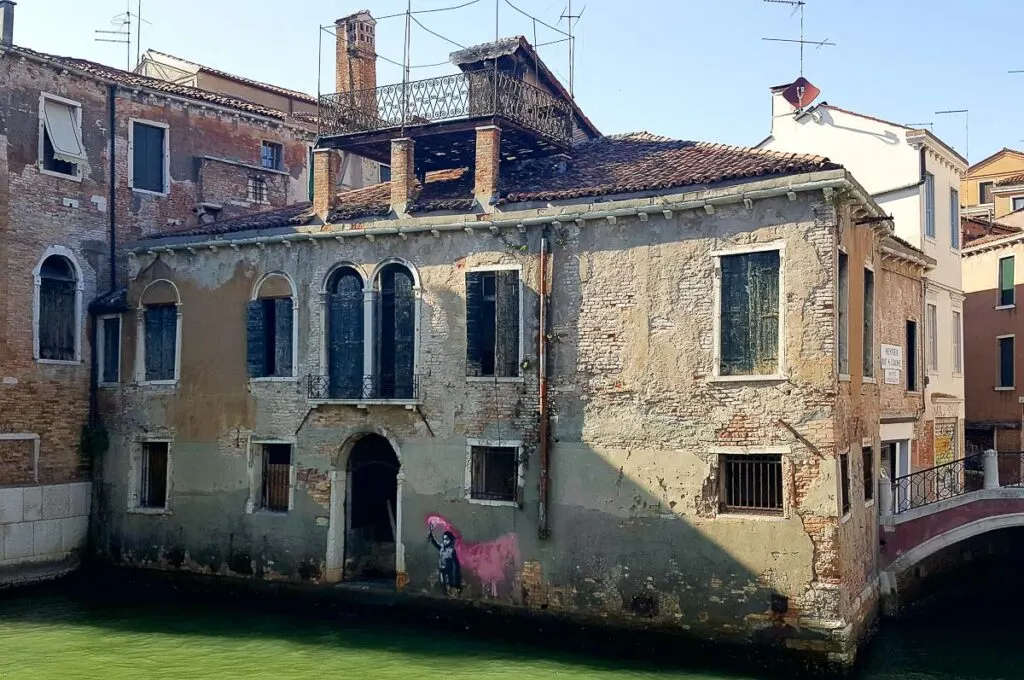
Banksy’s mural in Venice is on the wall of an old house just a few steps away from the Church of San Pantalon in the sestiere of Dorsoduro. It was painted in 2019 and it depicts a migrant child wearing a life jacket. In its right hand, the child holds a neon pink flare which provides a striking contrast against the dilapidated wall.
2. Ca’ Dario
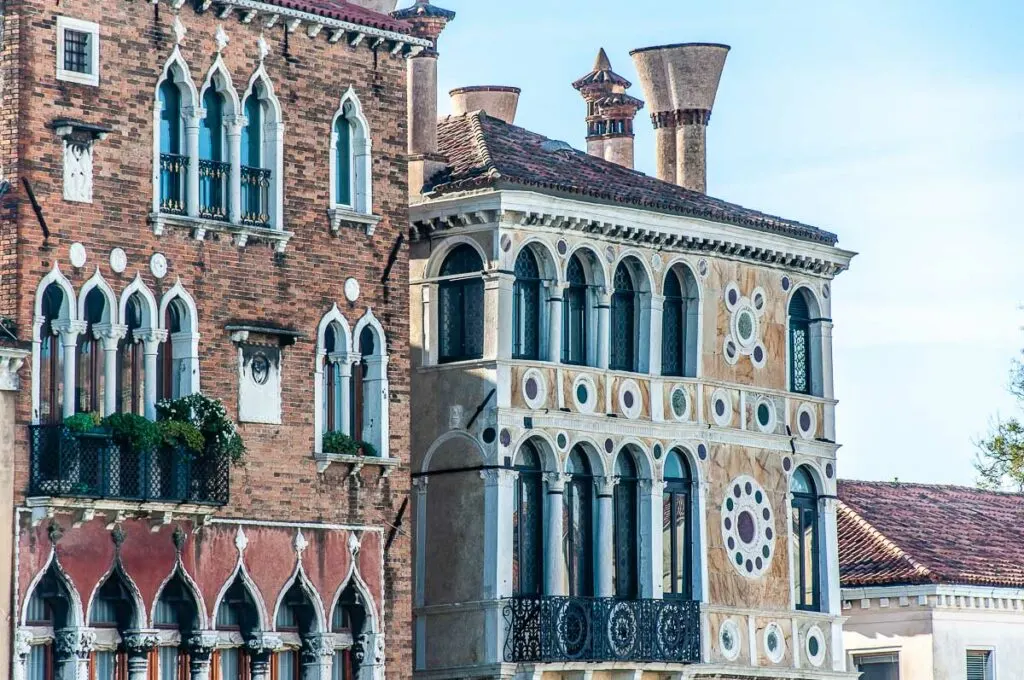
Ca’ Dario is a gorgeous patrician house in Dorsoduro. It faces the Grand Canal and it stands just a few steps away from Palazzo Venier dei Leoni (the building hosting the Peggy Guggenheim Collection). It has a stunning facade made of Istrian stone richly decorated with marbles and circular medallions.
Yet, for the last five hundred years, Ca’ Dario has been linked to numerous cases of bankruptcy and violent death. In the 15th century, the daughter of the first owner Giovanni Dario – who was the Secretary of the Senate of the Republic of Venice – killed herself after her husband went bankrupt and her son perished in a fight.
Since then, over 12 people who have owned the house have died either by their own hand, by sudden illness or in violent circumstances. One of them was the manager of The Who – Christopher Lambert.
On the facade of Ca’ Dario, there is an inscription which reads Urbis Genio Joannes Darius (Giovanni Dario to the Genius of the City). People have pointed out that the anagram of this otherwise noble saying actually means Sub ruina insidiosa genero (I bring treacherous ruins to those who live under this roof).
Other theories speculate that the palace had been built on top of an old Templar cemetery which, apparently, accounts for the incredible lack of luck its owners have.
Ca’ Dario is not open for visits. You can see its beautiful facade from the board of a vaporetto going down the Grand Canal. Or you can walk past the back end of the building on your way from the Peggy Guggenheim Collection to the Basilica della Salute.
For more haunting stories about Venice, have a look at this blog post:
3. Ca’ Foscari University of Venice
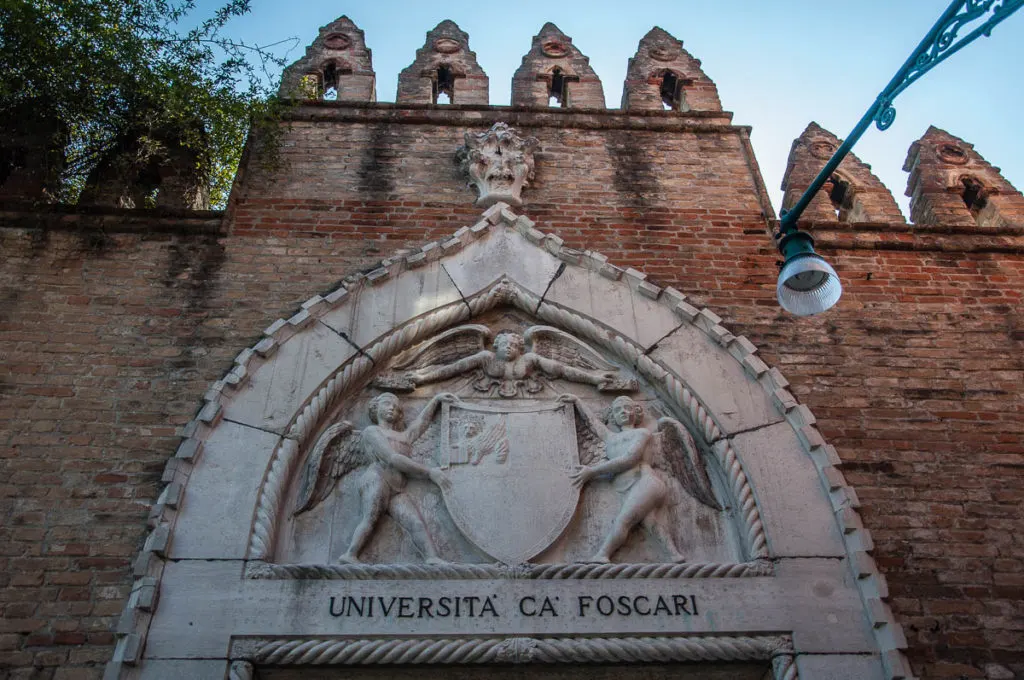
The Ca’ Foscari University of Venice was founded as a Royal High School of Commerce in 1868. A century later, it became a University. Nowadays, it has around 19,000 students and eight departments. It is also recognised as one of the best places to study languages and linguistics in Italy.
The University of Venice is housed in a stunning Gothic palace in the sestiere of Dorsoduro. It’s just a few steps away from Ca’ Rezzonico and the Gallerie dell’Accademia. The palace was built in 1453 for the Doge Francesco Foscari. They say that it is the only place on the Grand Canal that affords a view of the two iconic Venetian bridges – Ponte di Rialto and Ponte dell’Accademia.
The University of Venice can be visited as part of a guided tour led by the University students. The tours are free of charge and take place every Saturday. Click to find more details. Alternatively, you can also tour Ca’ Foscari virtually on Google Maps.
For more details about Ca’ Foscari and two more historic Italian Universities, have a look at this blog post:
4. Campo San Barnaba
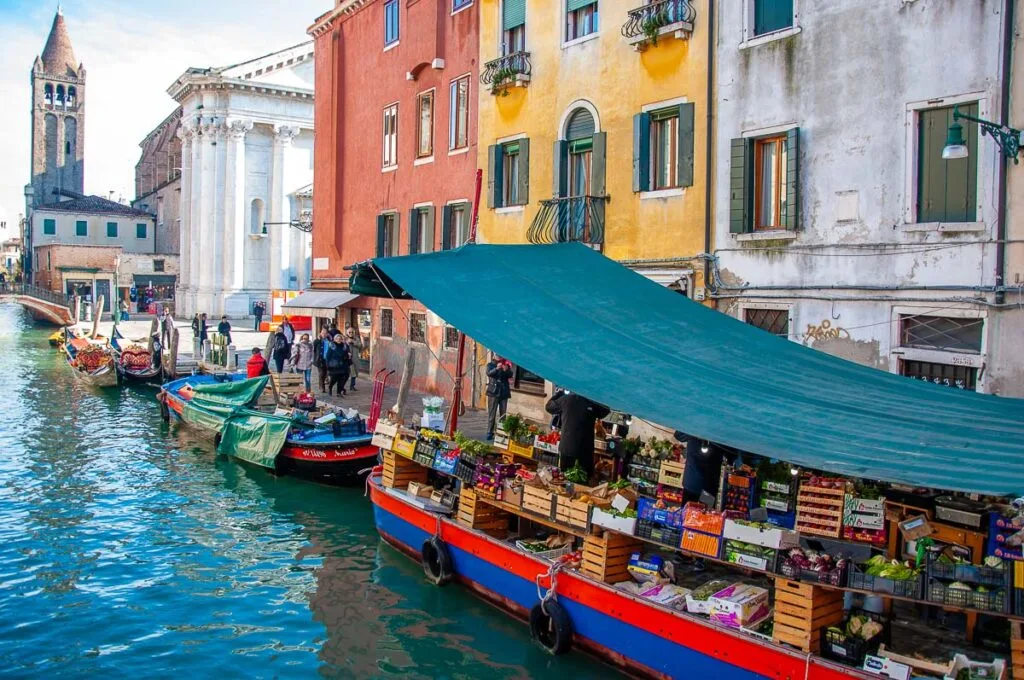
Campo San Barnaba is a small square in Dorsoduro. Full of life, it stands right next to or on the way to many of the other Venetian landmarks on this list. For example, the Ponte dei Pugni is just around the corner. You will also walk across Campo San Barnaba on your way from Venezia Santa Lucia train station to the Gallerie dell’Accademia.
Many shops and eateries flank the square turning it into a lively spot in Venice to enjoy for a few minutes or longer. For its cinematic beauty, Campo di San Barnaba has been featured in many films, not least Indiana Jones and the Last Crusade.
The imposing Neo-Classical facade of the deconsecrated Church of San Barnaba dominates the square. Nowadays, the church houses the Leonardo Exhibition – reproductions of machines based on the drawings and writings of the famous Renaissance artist and polymath.
For me, however, the best things to see right next to Campo San Barnaba are as follows:
- Barca di San Barnaba – a large barge used as a floating fruit and veg shop.
- Signor Blum – a colourful shop selling unique wooden puzzles, decorations, and toys.
- The Witch’s Alarm – an old alarm clock affixed near the roof of a yellow house on Calle della Toletta (2 mins away from Campo San Barnaba). According to the local legend, this used to be the abode of a witch who used an alarm clock to pick the best times for the casting of spells. They say that if the alarm clock is removed from the facade, strange things and hauntings start happening in the area.
5. Campo Santa Margherita
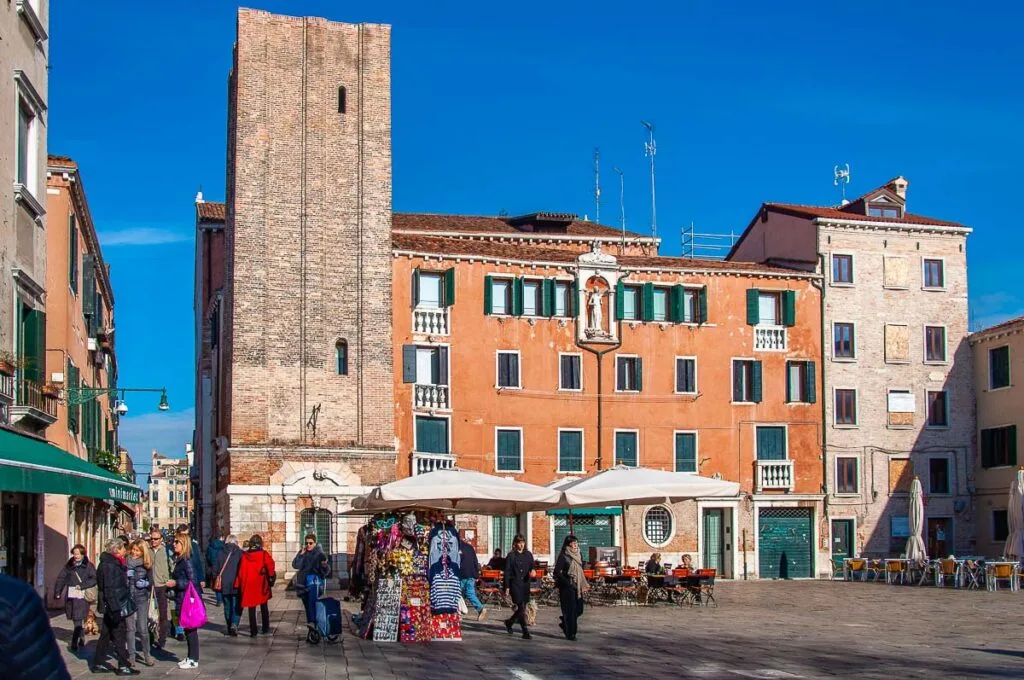
Campo Santa Margherita is one of Venice’s largest squares and liveliest urban spaces. With its fresh fish stall and lots of small shops, it’s the focal point of Dorsoduro’s community.
The numerous bars and eateries here attract students from the nearby Ca’ Foscari University of Venice. Every evening, they flock to the square to enjoy a spritz with their friends.
With its truncated bell tower, the deconsecrated Church of Santa Margherita dominates the square. Nowadays, it serves as a University auditorium. In the past, it was also used as a tobacco warehouse, a sculptor’s workshop, and even a cinema.
Come to Campo Santa Margherita in Dorsoduro not so much to sightsee but to experience Venice authentically. In a city with a constantly declining population, this expansive square still offers a peek into the Venetian lifestyle.
If you want to discover more about some of Italy’s most beautiful and historically interesting squares, have a look at this blog post:
6. Magazzini del Sale
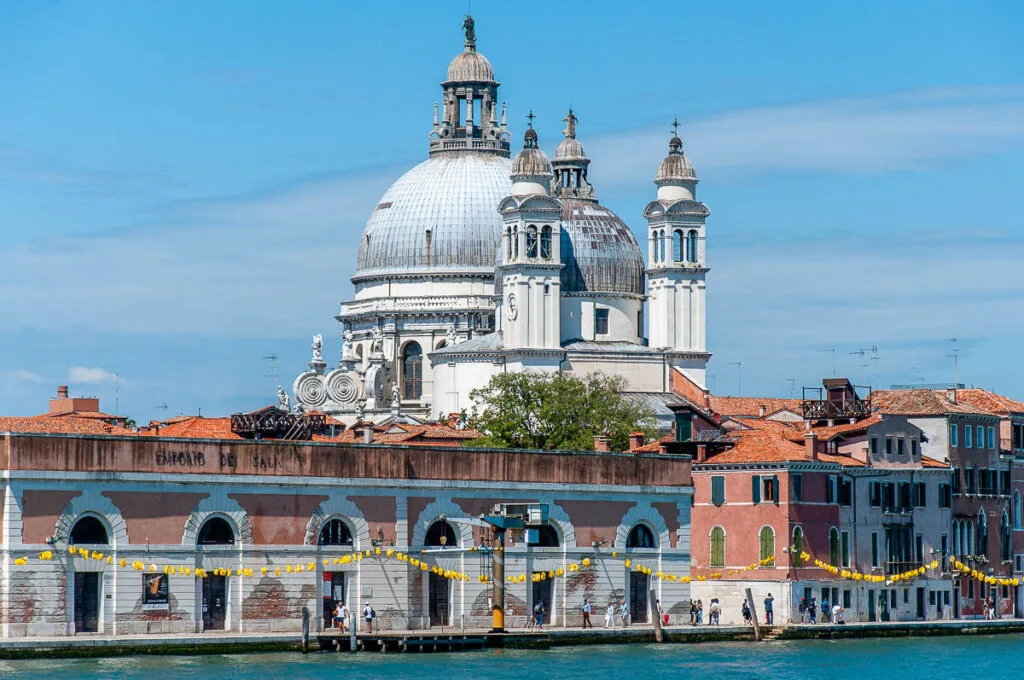
The Magazzini del Sale is a large building complex that in the past was used – as its name suggests – to store salt. It stands on the Fondamenta delle Zattere in Dorsoduro and it faces the Giudecca Canal.
In the past, salt was an important resource that the Republic of Venice produced, traded with, and used for the preservation of food. Hence, there was a need to build a large warehousing facility that could be easily reached by boats and could take in significant amounts of salt.
Nowadays, the complex of the Magazzini del Sale is an interesting place to visit in Dorsoduro. Especially, if you are a fan of industrial archaeology and art. The warehouses host several art foundations and organisations and are used as exhibition spaces. For forthcoming events, keep an eye on the website of the Emilio and Annabianca Vedova Foundation.
7. Palazzo Barbarigo and Palazzo Salviati
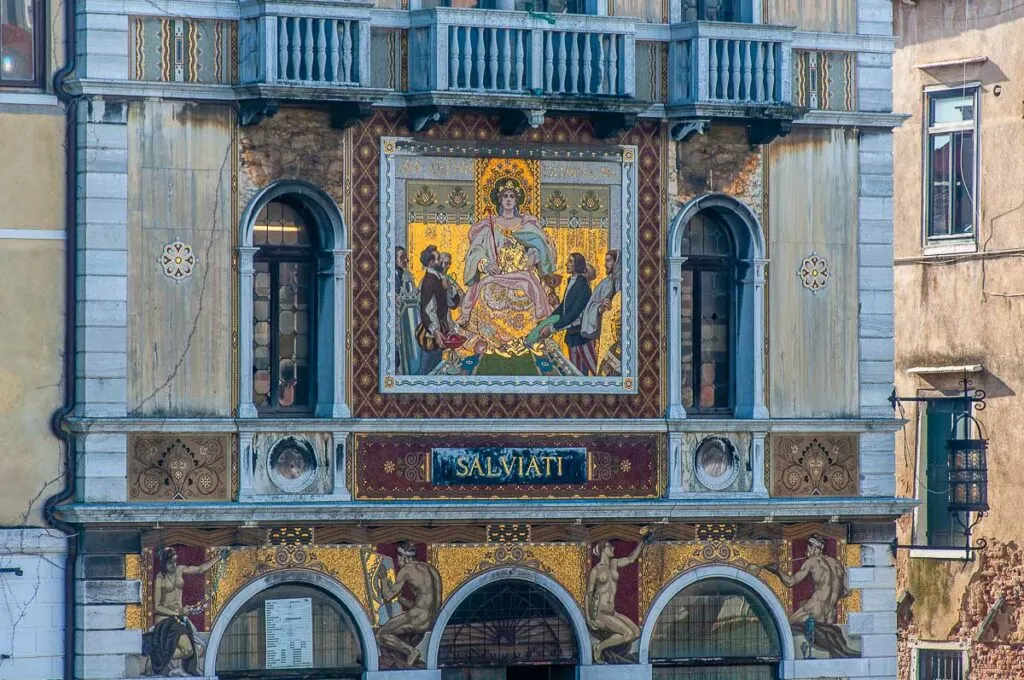
On account of their splendid mosaic panels, Palazzo Barbarigo and Palazzo Salviati are two of the most striking buildings flanking the Grand Canal on the Dorsoduro side.
Seeing them coming into focus as the vaporetto glides from Gallerie dell’Accademia down towards the Basilica della Salute is always one of my highlights in Venice.
Both palaces were owned by famous producers of Murano glass and Venetian mosaics. The Renaissance Palazzo Barbarigo was built in the 16th century. Palazzo Salviati was erected at the start of the 20th century.
Throughout the centuries, Venice has achieved some of the highest pinnacles in the art of mosaics. Intricate mosaic panels of large dimensions decorate several important churches in the Venetian Lagoon. Among them, St. Mark’s Basilica in the heart of Venice and the Church of Santa Maria Assunta on the island of Torcello are two of the most striking examples.
In the meantime, Palazzo Barbarigo and Palazzo Salviati on the Grand Canal give us an idea of the use of mosaics on residential buildings and the beauty that can be achieved through this medium.
8. Ponte dei Pugni
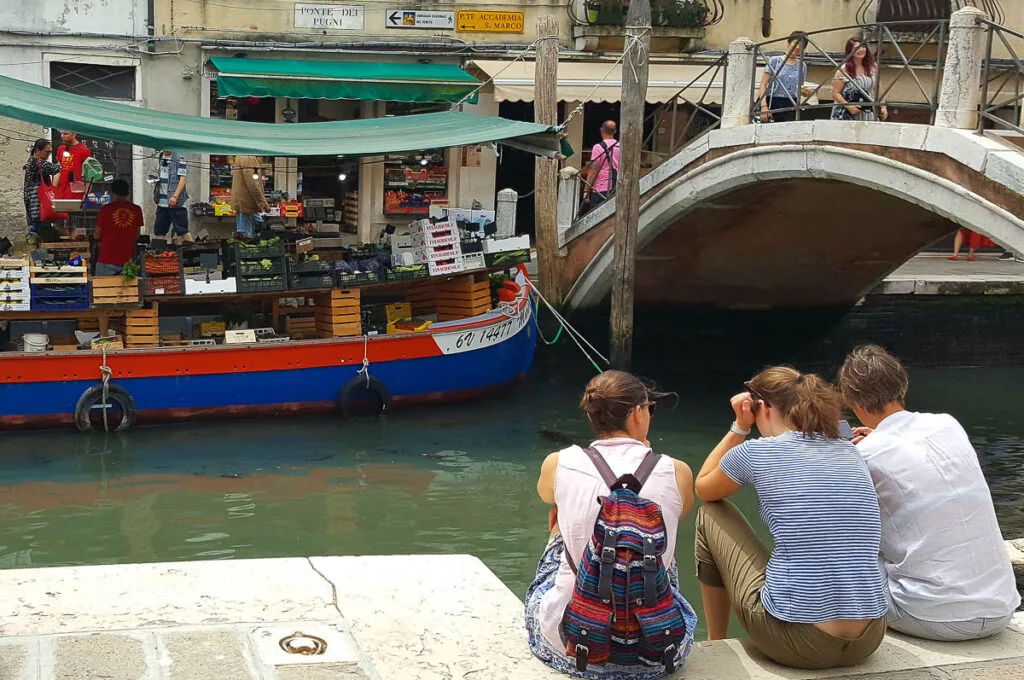
In English, the name of Ponte dei Pugni translates as Bridge of the Fists. This small and at a first glance unremarkable bridge stands just around the corner from Campo San Barnaba in Dorsoduro. You may even completely ignore the bridge on account of the curious sight right next to it – a large barge that sells fresh produce from the Venetian Lagoon.
Yet, Ponte dei Pugni is one of the most interesting bridges in Venice and it used to play an important role in the social life of the City of Canals. Look closely and you will spot four footprints made of white marble on the bridge.
They mark the starting position of fighters from warring Venetian clans who, centuries ago, would engage in fistfights on Ponte dei Pugni. The aim was to disbalance and throw your opponents into the cold water of the canal below. This was made easier by the fact that at the time the bridge – as all other bridges in Venice – didn’t have railings.
From the end of the 16th century to the very first years of the 18th century, fistfights were very popular entertainment in the City of Canals. While they were held on several bridges around town, the Ponte dei Pugni would attract the biggest crowds. There is a famous painting by the German artist Joseph Heintz the Younger showing a fistfight on the bridge.
9. Traghetto Across the Grand Canal
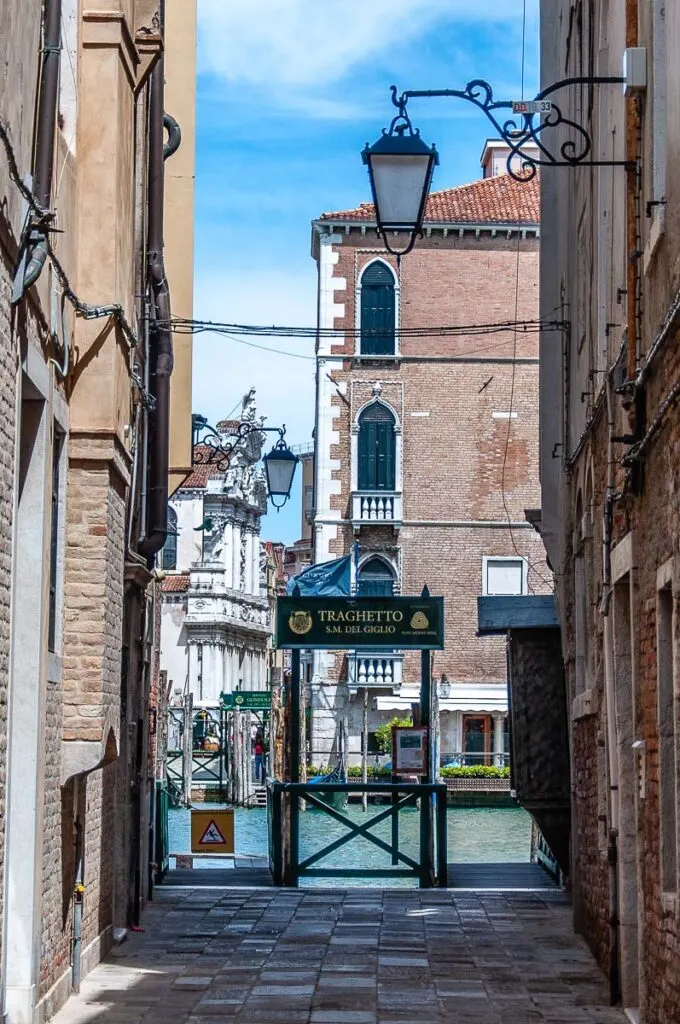
A traghetto is an unadorned black gondola with two oarsmen. It operates like a ferry and takes residents and visitors to Venice across the Grand Canal.
There are only four bridges over the Canalazzo as the locals like to call it. In the past, there used to be over 30 traghetto routes along its length of two miles. Nowadays, only a few of them remain.
Luckily, one of them connects the San Marco shore of the Grand Canal to its Dorsoduro side. As soon as there are enough passengers, the traghetto leaves from its stop near the Church of Santa Maria del Giglio in the sestiere of San Marco. A couple of minutes later it reaches the opposite side. Its Dorsoduro stop is halfway between the Peggy Guggenheim Collection and the Basilica della Salute.
Costing a couple of euros per person or much cheaper if you have invested in a Venezia Autentica card, the traghetto is a very convenient way to cross the Grand Canal.
Traditionally, the passengers need to stand upright during the crossing. Nowadays, however, the oarsmen often ask you to sit down. Especially, when they see that most of the passengers are not from Venice.
V. Must-See Shops, Workshops, and Eateries in Dorsoduro in Venice, Italy
If you like shopping and eating (and who doesn’t?!), here are a few must-see destinations for you to explore in Dorsoduro in Venice. Add them to your itinerary of this corner of the City of Canals as each one of them will give you a new angle to enjoy Venice from.
1. Ca’ Macana
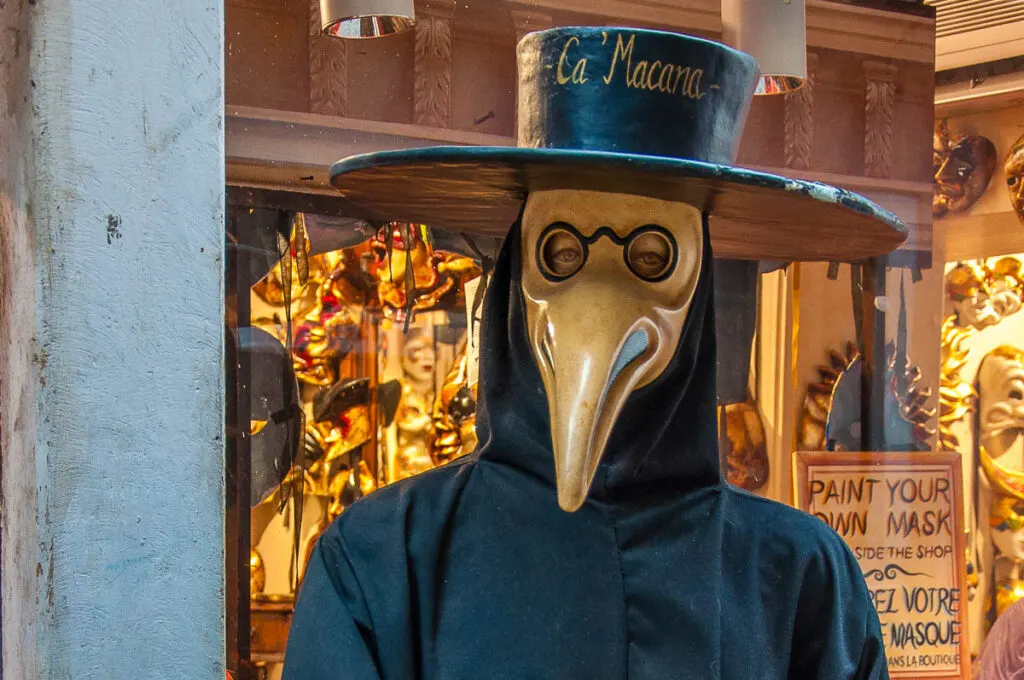
Ca’ Macana is one of Venice’s oldest mask-making shops. With the revival of the Venetian Carnival back at the end of the 1970s, the ancient craft of mask-making was brought back to life, too. Not in small measure due to the enthusiasm, efforts, and research of Davide Belloni and Antonella Masnata who founded Ca’ Macana in 1984.
Their masks have been used in many films and fashion shoots. They also grace the homes and parties of thousands of Venetian mask aficionados all around the world.
Ca’ Macana has two shops in Venice. Both are in the sestiere of Dorsoduro. Here, they also have a workshop which is specially outfitted for mask making and mask decorating courses.
To learn more about the history and the traditions of Venetian masks and the Venetian Carnival, have a look at these two blog posts:
- 10 Facts About Venetian masks – History, Traditions, and Meaning
- Carnival of Venice – History and Traditions of the World’s Most Illustrious Party
2. Nico Gelateria
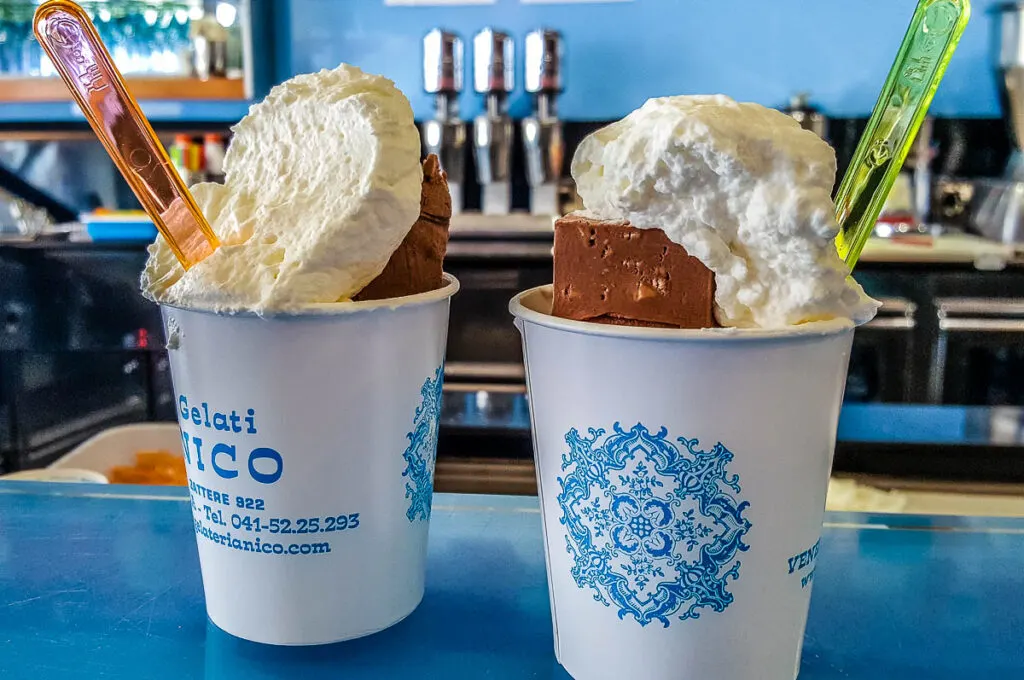
There are many shops selling gelato in Venice but Nico Gelateria is special. Since 1937 it has been standing on Fondamenta delle Zattere in Dorsoduro enjoying great views of the Giudecca Canal.
Venetians love to come here for Nico’s gianduiotto. This is a thick slab of frozen chocolate praline with pieces of hazelnuts studded in it. It’s served topped with delicious whipped cream.
3. Osteria Al Squero
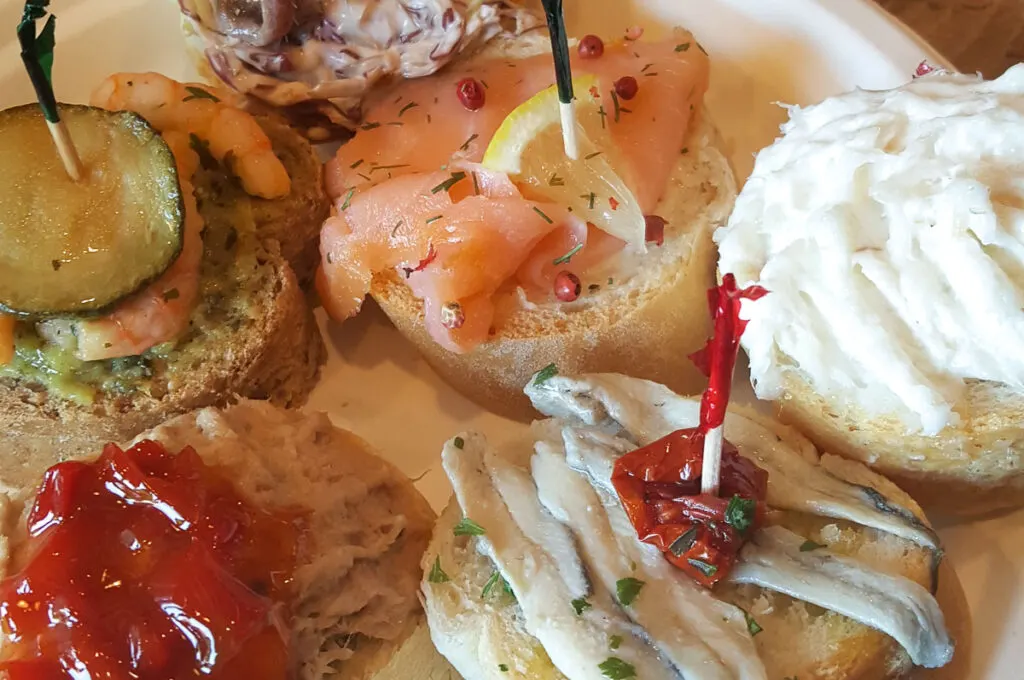
Osteria al Squero is a small traditional eaterie just across the canal from the gondola-making boatyard Squero di San Trovaso.
It serves a wide selection of cicchetti – traditional Venetian finger foods. Especially popular are its crostini – small slices of crusty bread topped with delicious salami, refined prosciutto, selected cheeses, fresh seafood, and seasonal vegetables.
People get a selection of crostini on a paper plate, order a spritz or a glass of prosecco and then lean against the brick wall on the edge of the canal and enjoy the view of the gondola-makers at work. The Church of San Trovaso towers over this typically Venetian scene.
Visiting the osteria to sample its cicchetti while looking out at the squero is one of the best things to do in Dorsoduro in particular and in Venice as a whole.
Nearby, don’t miss the Cantine del Vino gia’ Schiavi for one of the best selections of wines and spirits in the City of Canals.
4. Signor Blum
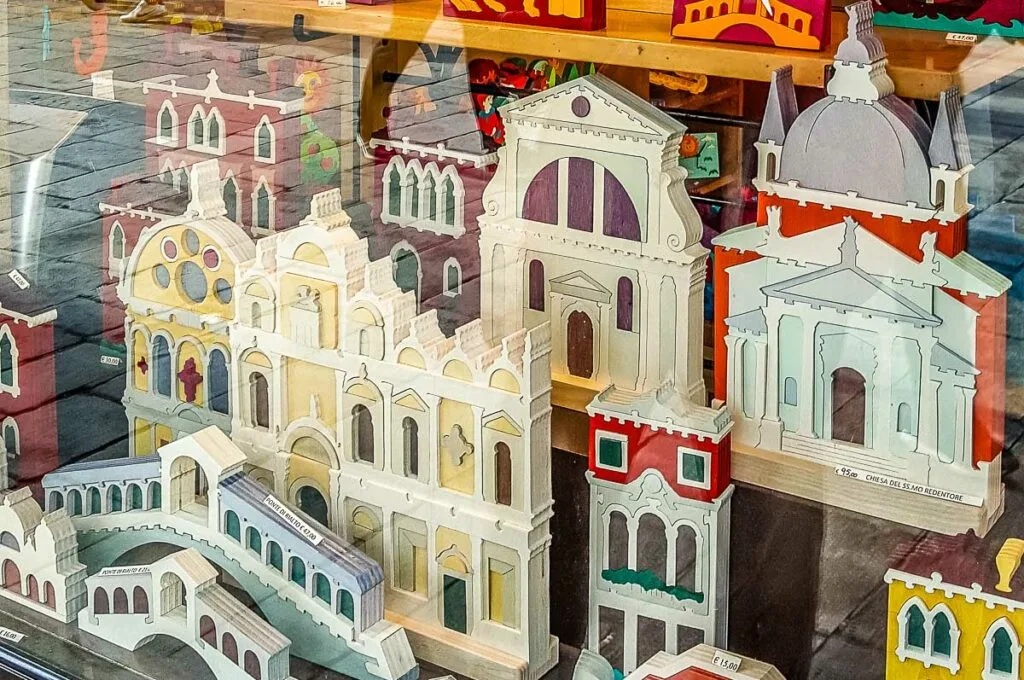
Signor Blum is a wonderfully colourful artisan shop in Dorsoduro. It stands right between the Ponte dei Pugni and the Campo San Barnaba. It sells wooden puzzles, decorations and toys. It’s a truly fun place to visit for unique mementoes from Venice.
5. Squero di San Trovaso and Squero Tramontin
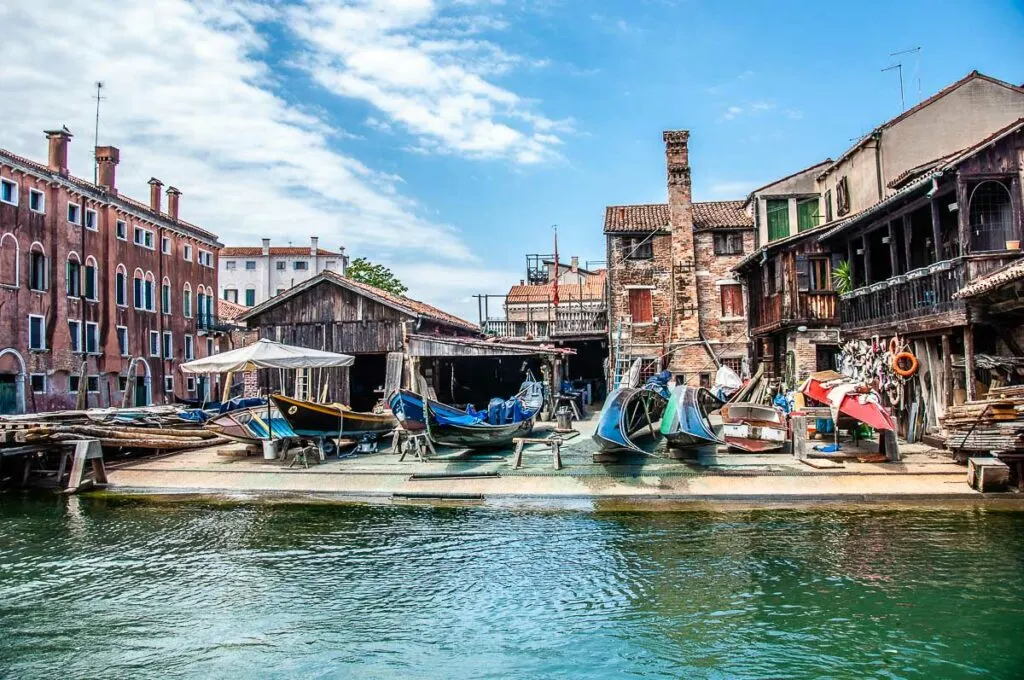
A squero is a Venetian boatyard specialising in the construction and repair of traditional for Venice boats. Most importantly, gondolas.
While even a few decades ago there used to be dozens of squeri in Venice, nowadays there are only a few of them left that are still in operation. Squero di San Trovaso is the most famous of them all. You will find it right next to the imposing Church of San Trovaso in the sestiere of Dorsoduro.
The squero is not usually open for visits, so people congregate across the small canal Rio di San Trovaso to watch the gondola-makers at work. Many grab a plate of Venetian snacks – cicchetti – and a glass of spritz from Osteria Al Squero to enjoy while looking out at the traditional boatyard.
I had a chance to visit Squero di San Trovaso some years ago as part of a special event for charity. I truly enjoyed the stories we learned there about the Venetian gondolas.
Just up the road from Squero di San Trovaso, you will find Squero Tramontin – another well-known Venetian boatyard. Founded in 1884 by Domenico Tramontin, nowadays it’s run by sisters Elena and Elisabetta who continue in the steps of their gondola-making father Roberto Tramontin. You can book a visit to this squero through its website.
6. Barca di San Barnaba
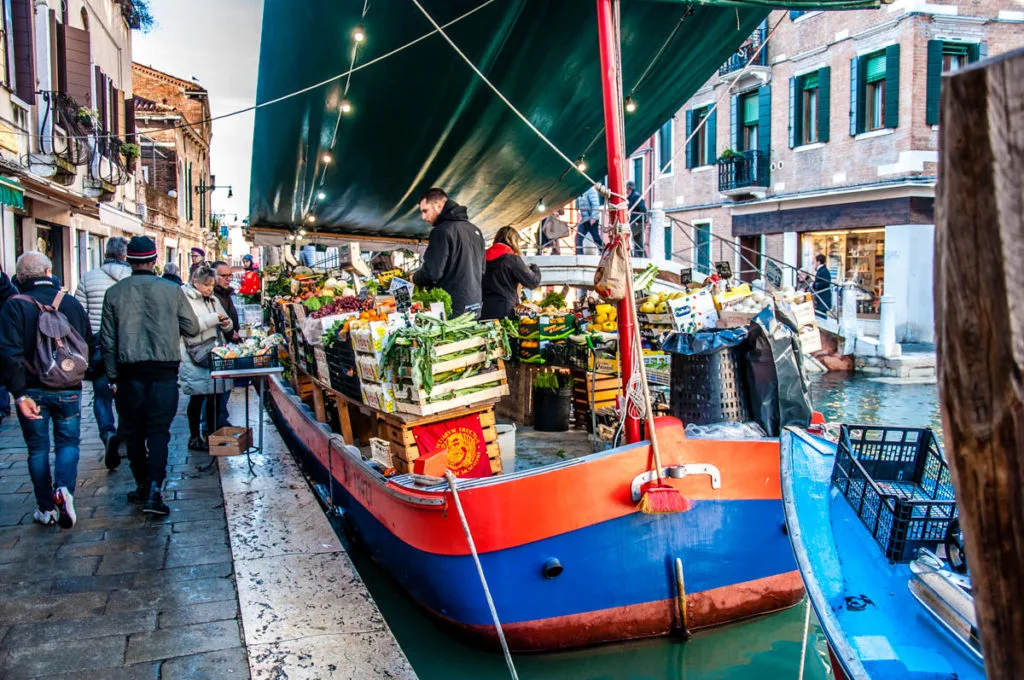
Barca di San Barnaba (in English, St. Barnabas’ Boat) is a long barge that doubles as a fruit and veg shop. From Monday to Saturday, you will find it moored right next to the Ponte dei Pugni in the Venetian sestiere of Dorsoduro.
The barge is one of Venice’s most curious sights. Covered in crates, here you will find seasonal fruit and veg freshly picked from the orchards in and around the Venetian Lagoon. In a city built on water, there is something very charming about buying your fresh produce from a boat.
If you visit the City of Canals in spring, then make sure that you stop at the Barca di San Barnaba and buy some castraure. These are the first and tenderest buds of the purple artichokes that are cultivated on the island of Sant’Erasmo – also known as the Orchard of Venice.
VI. Must-See Sights and Landmarks on the Island of Giudecca in Dorsoduro in Venice, Italy
Administratively, Giudecca is part of the sestiere of Dorsoduro. Yet, this long and thin island is a world of its own. If you have the time, then by all means take the vaporetto across the Giudecca Canal and enjoy a long walk across the island’s peaceful squares and narrow streets that keep the authentic spirit of Venice still alive.
From hidden gardens to stunning buildings, there is lots to see and do here. If you can, make sure that you dedicate a whole day to Giudecca to experience it fully. Here are five of Giudecca’s main points of interest to start your exploration with.
1. Cantiere Nautico Crea
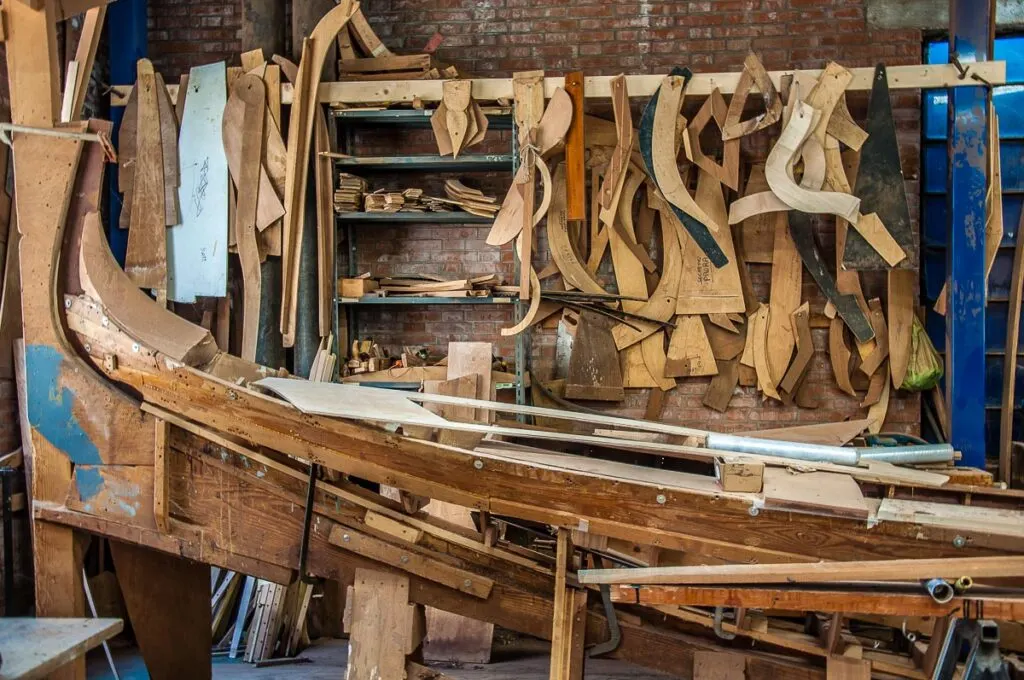
The Cantiere Nautico Crea was founded by Vianello Gianfranco Crea – seven times winner of the Historical Regatta – Venice’s largest and most important boat race. The boatyard tailor-makes boats and specialises in the production and repair of traditional Venetian gondolas.
The workshop of the Cantiere Nautico Crea on the island of Giudecca is a work of art in itself. It’s lined up with the hulls of boats at different stages of manufacture. On the walls hang hundreds of different tools and patterns used in the making of gondolas. It’s a hidden gem in Venice.
At the end of the boatyard, there is a restaurant, too. Al Storico da Crea serves traditional Venetian dishes and has a lovely view over some of the lesser-known and visited islands in the Venetian Lagoon.
2. Casa dei Tre Oci
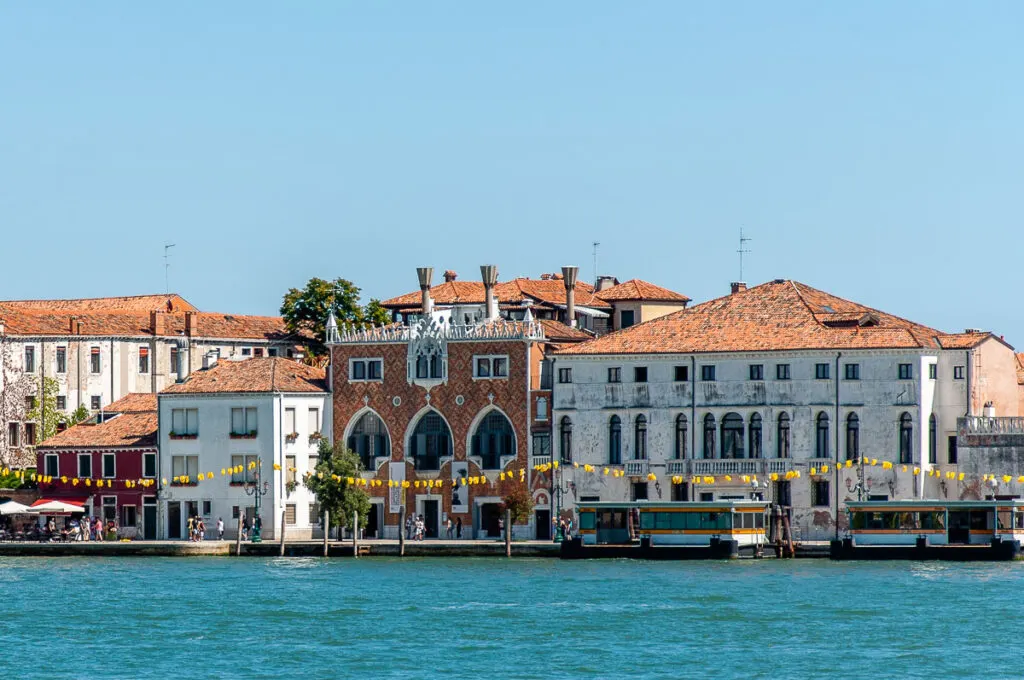
The Casa dei Tre Oci is one of the houses with the most beautiful facades not just on the island of Giudecca but in the whole of Venice, too. In the Venetian language, its name means the House with the Three Eyes. This is on account of its three arched windows at the front.
The house is just over a century old. It was built in the Neo-Gothic style by Mario de Maria – a painter from Bologna. They say that the three large windows on the facade symbolise his family – a father, a mother, and a son. The small window above them pays homage to the painter’s daughter who died as a child.
Nowadays, the Casa dei Tre Oci hosts photographic exhibitions and a photo archive.
3. Church of Santa Maria della Presentazione (Le Zitelle)
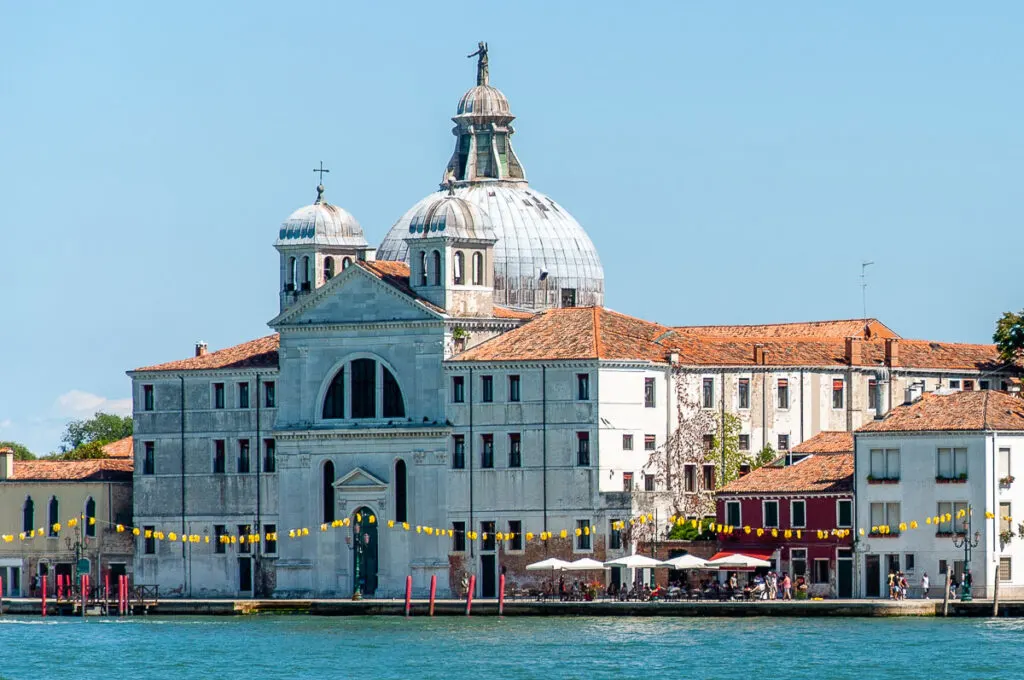
The Chiesa di Santa Maria della Presentazione is a late 16th-century church at the eastern end of the island of Giudecca.
It’s commonly known as the Church delle Zitelle from the Venetian word for a young girl of marriageable age. This is due to the fact that the church was part of a religious complex that provided training in lace-making and sewing to poor Venetian girls without a dowry. Unable to get married, without the useful skills they learned here, many of them would have had to turn to prostitution to survive.
4. Church of the Santissimo Redentore
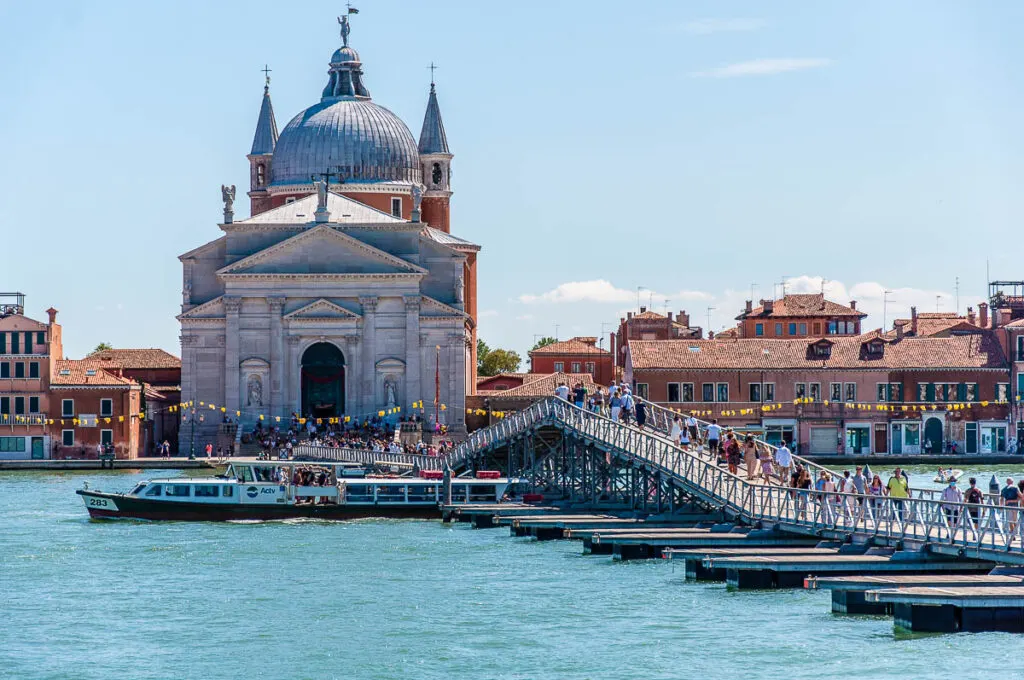
The Church of the Santissimo Redentore (commonly known simply as Redentore or Redeemer in English) is one of Venice’s most famous and beautiful churches. Designed by the renowned Renaissance architect Andrea Palladio, its striking marble facade looks like a classical temple with perfect proportions.
The Redentore is also one of Venice’s five Plague Churches. It was built in the 16th century to give thanks to God for delivering the City of Canals from yet another devastating bout of the plague.
To this day, one of Venice’s largest celebrations centres around the Redentore Church. On the third weekend of July, traditionally, a temporary bridge is built of barges. It links the Fondamenta delle Zattere in Dorsoduro to the Redentore on the island of Giudecca.
People come to cross the bridge and attend mass which is served every hour in the church. In the evening, large-scale fireworks light the sky above Venice for over an hour. It’s an amazing spectacle to see and one of the most authentic moments throughout the year to capture the spirit of the City of Canals.
5. Hilton Molino Stucky
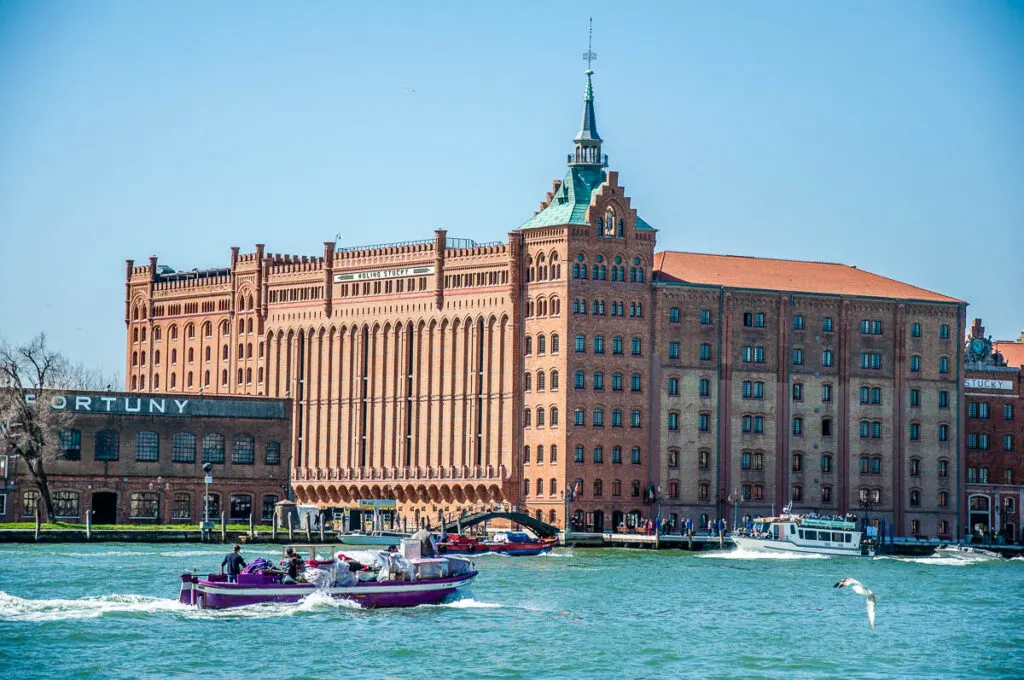
From many different points of view, Molino Stucky is one of the most interesting buildings on the island of Giudecca and in the whole of Venice. On the one hand, its enormous body towers over the Giudecca Canal and grabs the eye as you walk along the Fondamenta delle Zattere on the opposite bank.
On the other hand, Molino Stucky is one of the best testaments to the rapid industrialisation that took place in Venice towards the end of the 19th century. This massive building was originally a flour mill and a pasta factory.
Nowadays, Molino Stucky is one of the most luxurious destinations in Venice. It was converted into a 5-star Hilton hotel in 2007. It offers such extras as a rooftop swimming pool, the city’s largest ballroom, and splendid panoramic views over the Venetian Lagoon.
One-Day Itinerary for Dorsoduro in Venice, Italy
Here is a handy one-day itinerary taking in the major landmarks, art-filled churches, and hidden corners of the sestiere of Dorsoduro in Venice, Italy. It will take you from Venezia Santa Lucia train station to the Punta della Dogana.
There is lots to see along the way. If you only have a day or a few hours at your disposal to explore Dorsoduro, you will need to decide for yourself which sights you want to spend time at and which you simply want to see from the outside and then continue walking.
For example, you may decide to spend an hour in Ca’ Rezzonico and an hour and a half or two in the Gallerie dell’Accademia but skip Palazzo Cini and the Peggy Guggenheim Collection on account of your personal interest and respective lack of interest in particular types of art.
There are no right and wrong decisions here. Just decisions made based on your available time, physical endurance, and personal interests. In any case, there will be difficult decisions to make as Dorsoduro really has so much to offer. So, if you want to see it all and do it all, consider spending a couple of days here instead of a couple of hours.
The itinerary shown on the above map of Dorsoduro includes the following sights:
Venezia Santa Lucia Train Station – The Migrant Child Mural by Banksy – Church of San Pantalon – Ca’ Foscari University of Venice – Campo Santa Margherita – Scuola Grande dei Carmini – Church of Santa Maria dei Carmini – Church of San Sebastiano – Ponte dei Pugni – Campo San Barnaba – Ca’ Rezzonico – Osteria Al Squero – Church of Santa Maria del Rosario (Gesuati) – Gallerie dell’Accademia – Accademia Bridge – Palazzo Cini – St. George’s Anglican Church – Peggy Guggenheim Collection – Basilica della Salute – Punta della Dogana – Traghetto Stop Santa Maria del Giglio
This is only one of many possible itineraries to follow around Dorsoduro. Feel free to adjust it to your needs and interests. If you click on the grey star next to the map’s name, this will add it to your favourites in Google Maps and you can then refer to it as and when you want.
As Google Maps allows only up to ten stops to be added under each layer with directions, the above itinerary has been split into three different layers:
- from Venezia Santa Lucia to Campo San Barnaba;
- from Campo San Barnaba to the Basilica della Salute;
- and from the Basilica della Salute to the Traghetto Stop Santa Maria del Giglio
It is, however, the same itinerary that takes you all around Dorsoduro. Again, you can adjust it as you see fit.
If you click on the sliding window icon in the top left corner of the map, you will see a list of all sights included in this Dorsoduro itinerary. If you click on the icon in the top right corner of the map, you will open the map in a new browser tab for better visibility.
You can start your exploration of Dorsoduro from Venezia Santa Lucia train station and then follow the different steps of the itinerary. In this case, once you finish, you can either:
- take a vaporetto (Venice’s water bus) from the Basilica della Salute across to St. Mark’s Square; or
- take the traghetto from the Santa Maria del Giglio stop across the Grand Canal and then a vaporetto back up to the train station.
Alternatively, at the start of the day, you can take a vaporetto from the train station down the Grand Canal to the Basilica della Salute and then begin the itinerary from its endpoint back to its beginning.
Under the Practical Tips section below, you will find information about the vaporetto lines to use.
Practical Tips About Visiting Dorsoduro in Venice, Italy
Pin for Later!

How to Reach Dorsoduro in Venice, Italy?
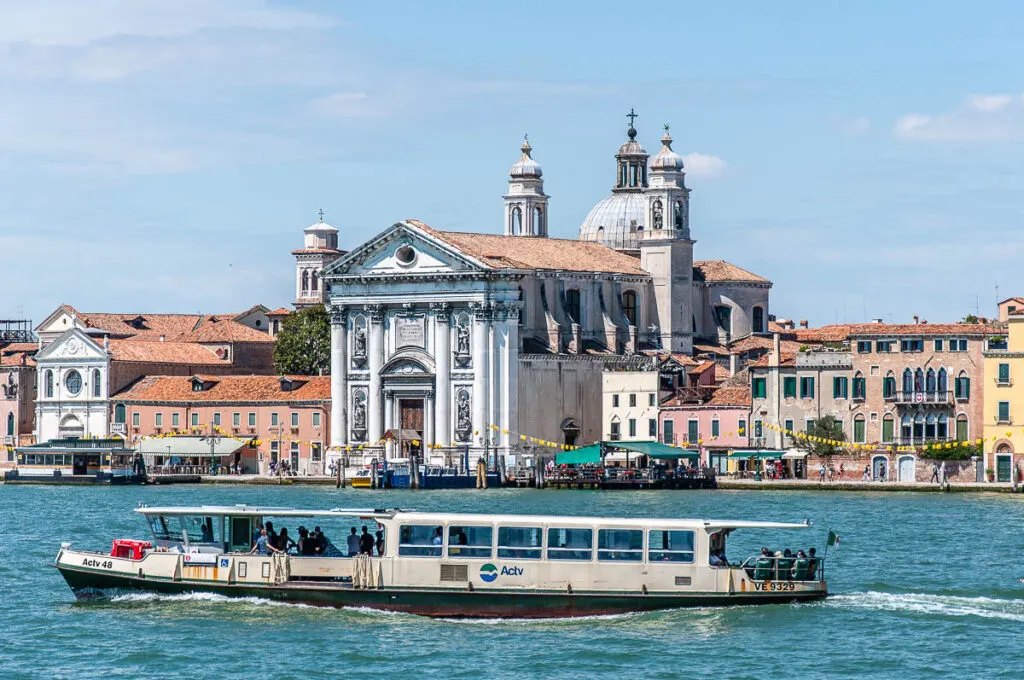
Dorsoduro is one of Venice’s six sestieri – or neighbourhoods. You can reach it either on foot or by boat. Here is how it works:
On Foot:
Starting from Venice’s train station – Venezia Santa Lucia – you can walk to Dorsoduro in about 15-30 mins depending on your final destination. For example:
- from Venezia Santa Lucia to Ca’ Rezzonico – 19 mins;
- from Venezia Santa Lucia to Gallerie dell’Accademia – 23 mins;
- from Venezia Santa Lucia to Basilica della Salute – 30 mins.
Starting from St. Mark’s Square, you can walk to Dorsoduro in about 15 mins. You will need to walk across the Accademia Bridge over the Grand Canal.
By Boat:
Starting from Venice’s train station – Venezia Santa Lucia – you can take a vaporetto either down the Grand Canal or the Giudecca Canal to reach Dorsoduro in about half an hour or so. A vaporetto is a water bus – the usual type of public transport used in Venice. Click here to buy single tickets, daily and multi-day passes for Venice’s vaporetti in advance.
Click on the links below to see the timetables of the respective vaporetti.
- Vaporetto Line 1 – it will take you down the Grand Canal to Ca’ Rezzonico, Gallerie dell’Accademia, and the Basilica della Salute.
- Vaporetto Line 2 – this is a circular line which runs in both directions, so you have two choices here. You can take this vaporetto down the Grand Canal to Gallerie dell’Accademia. Or you can take it down the Giudecca Canal to the Fondamenta delle Zattere and then to various stops along the island of Giudecca.
Starting from St. Mark’s Square, you can take either a vaporetto or a traghetto across the Grand Canal to Dorsoduro. Traghetto is an unadorned black gondola with two oarsmen. It takes passengers across the Grand Canal for a small fee.
- Vaporetto Line 1 – it will take you from Santa Maria del Giglio stop across the Grand Canal to the Basilica della Salute.
- Vaporetto Line 2 – it will take you from San Marco Giardinetti stop across the Grand Canal to the Gallerie dell’Accademia.
- Traghetto – the nearest traghetto stop is next to the Church of Santa Maria del Giglio. The crossing of the Grand Canal takes only a couple of minutes. The traghetto will drop you off near the Peggy Guggenheim Collection. The Gallerie dell’Accademia and the Basilica della Salute are a short walk away in opposite directions to one another. If you don’t have a daily ticket for the vaporetto, then by all means use the traghetto. It’s cheaper and riding it is a truly authentic Venetian experience.
Alternatively, you can book a private water taxi to take you to Dorsoduro from wherever you are in Venice.
Where to Stay in Dorsoduro in Venice, Italy?

You can find all sorts and types of accommodation in Dorsoduro to suit any budget. From luxury hotels to cosy B&B’s and comfortable hostels, there is something for everyone. Plus, on the island of Giudecca, you will find two of the very few hotels in Venice with a swimming pool. One is Hilton Molino Stucky and the other is the Cipriani Hotel.
No matter where you choose to stay in Dorsoduro, make sure that you book well in advance. Especially, if you are planning to visit during the high season or for the Venetian Carnival. Venice is always a popular destination and many visitors return time and time again. Prices can rise steeply depending on the season and how little time there is between now and your visit.
For ideas about the types of accommodation available in Venice in particular and Italy in general, have a look at this blog post:
I usually prefer to book all my accommodation through Booking.com. Click to see all available options for places to stay in Dorsoduro in Venice. These hotels come highly recommended:
Budget: Hotel Pausania, Antica Locanda Montin
Mid-Range: Hotel Moresco, Ca’ San Trovaso
Luxury: Excess Venice Boutique Hotel & Private Spa, Hotel Palazzo Stern
If you need some visual help in terms of precise location and price range, have a look at this map. It gives you a quick idea of the prices and whereabouts of the many hotels and other forms of accommodation you can book for your stay in Dorsoduro.
You can zoom in and out in order to search for a place to stay. You can also click on the option that interests you to find out more details or to make a booking directly.
Booking.comWhat to Wear for a Visit to Dorsoduro in Venice, Italy?
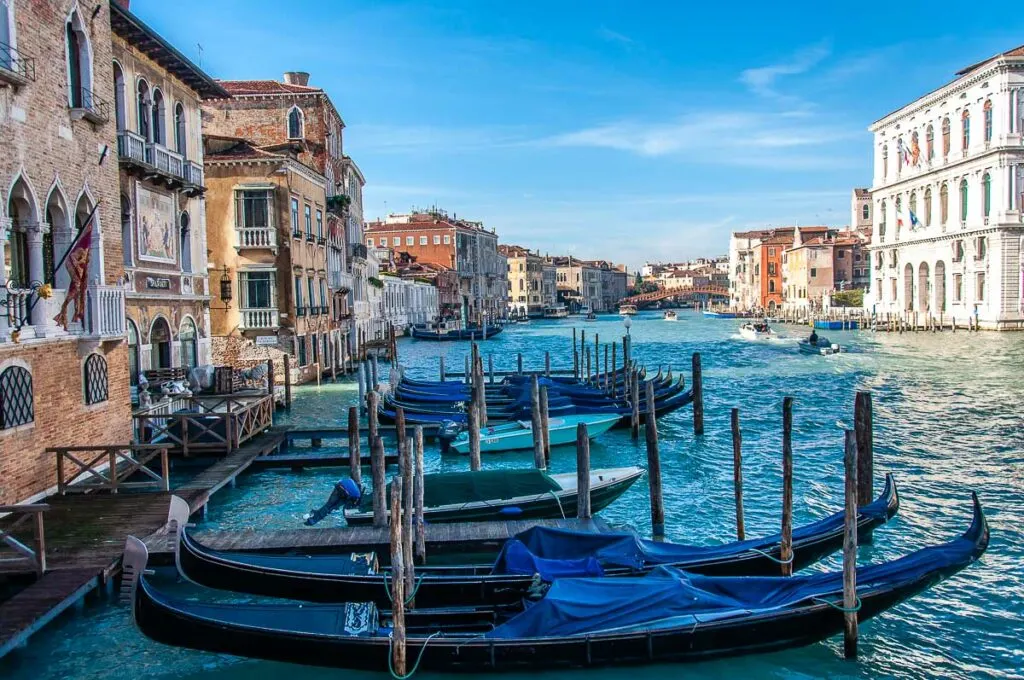
When choosing what to pack for your visit to Dorsoduro in Venice, Italy, you need to keep two concepts in mind: comfort and decorum.
Venice is an absolutely exciting place to visit but all the sightseeing and walking around it can be extremely tiring. Especially, if you are not used to being on your feet all day.
As such, make sure that you pack your most comfortable clothes and shoes. In summer, opt for clothes from thin natural fabrics that keep you cool and fresh. Bring suncream and a hat as the sun glare can be very intense in Venice.
In winter, layer up. The high humidity makes the City of Water feel colder than the actual temperature and produces a bone-freezing chill.
Shoes need to be comfy and with a good grip. You will be walking all day on historic pavements, going up and down stone bridges and steps. You’ll want your feet and ankles to be protected and well-supported.
In terms of decorum, think of Venice as a living museum. Avoid bare shoulders, shorts, and mini skirts. Churches have a dress code and you may be refused entry if you turn up in a revealing outfit. The Venetians also expect visitors to their city to behave respectfully. This fully applies to how one dresses and presents themselves.
Where to Find More Information About Dorsoduro in Venice, Italy?
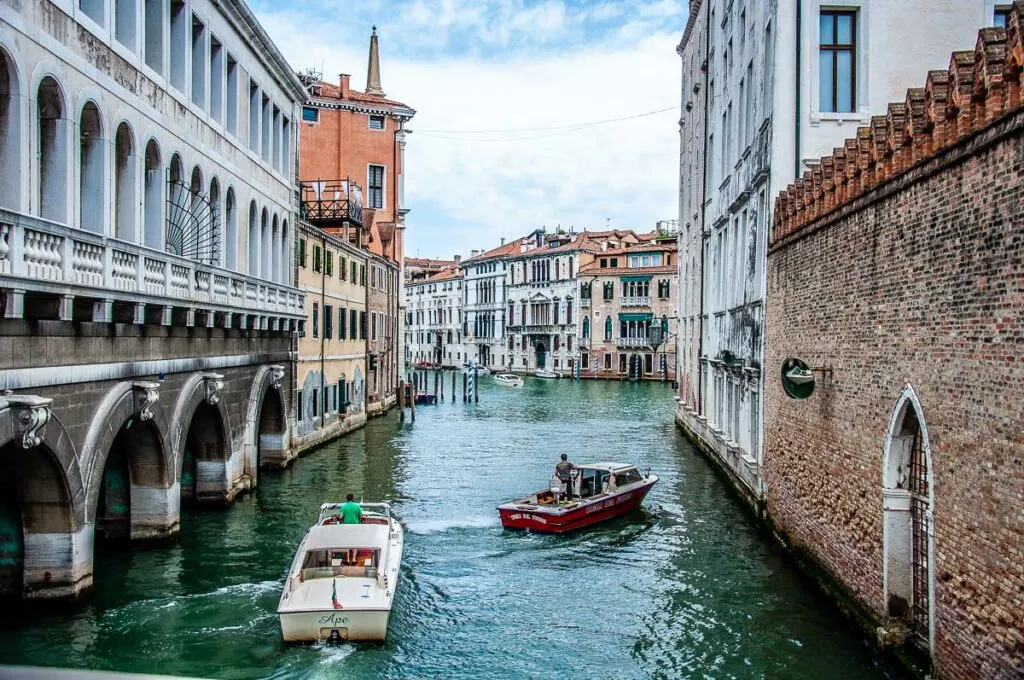
There are many books about Venice that explore in detail the main landmarks and the hidden corners of the Venetian sestiere of Dorsoduro.
Below I have listed two of my favourite ones. They will give you even more in-depth information about the most exciting and curious things to do in this underrated corner of the city of Venice in Italy.
111 Places in Venice That You Must Not Miss by Gerd Wolfgang Sievers
Secret Venice – An Unusual Travel Guide by Thomas Jonglez
Where to Find More Information about Venice, Italy?
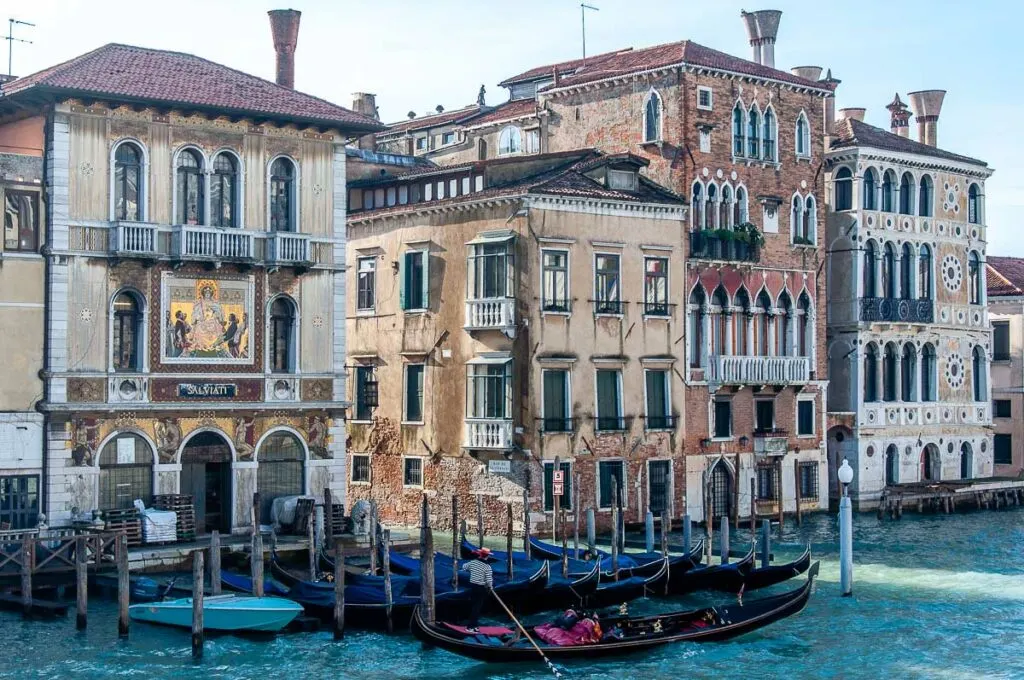
Venice is a very popular topic to write about. A simple Google search will return millions of results providing you with information about travelling to and exploring the City of Canals.
In addition, many books have been written about Venice. They delve into the millennial history of the Floating City, explain in detail the practicalities of visiting it or use it as a marvellous stage for romance and tragedies.
It’s not very humble of me to say it but if you are looking for detailed, well-researched, and first-hand tried and tested information about Venice, have a look at my relevant blog posts.
I have been visiting Venice for close to twenty years now and writing about it for close to ten years. On the pages of this blog, I have shared lots of useful information. I hope that it will come in very handy during the preparatory stages of your Venetian holiday.
Here are the relevant links:
Venice: Essential Tips, Things to Do, Major Landmarks, Hidden Gems, How to Navigate Venice, Venice in a Day for Art Lovers, Train Stations, Nearest Airports, Best Tours, Beaches of Venice, Quotes about Venice, Boats in Venice, Haunted Venice, Day Trips from Venice, Arco del Paradiso
Travel to and from Venice: Treviso to Venice, Verona to Venice, Florence to Venice, Milan to Venice, Bologna to Venice, Venice to Lake Garda, Venice to Padua, Venice to Verona, Venice to Milan
Venice Videos: Grand Canal, St. Mark’s Square at Carnival, St. Mark’s Square, View from Rialto Bridge, View from Accademia Bridge, Venetian gondolas, Historical Regatta, Squero di San Trovaso, Palazzo Contarini del Bovolo, Fondazione Querini Stampalia, Palazzo Grimani, Rialto Fish Market, Ca’ Macana, Festa della Madonna della Salute
Finally, have a look at my Amazon Shop. I have a special section with all the best books about Venice in terms of history, travel, art, and fiction writing. There is a lot to read and a lot of exciting information to uncover about the City of Canals.
In Conclusion
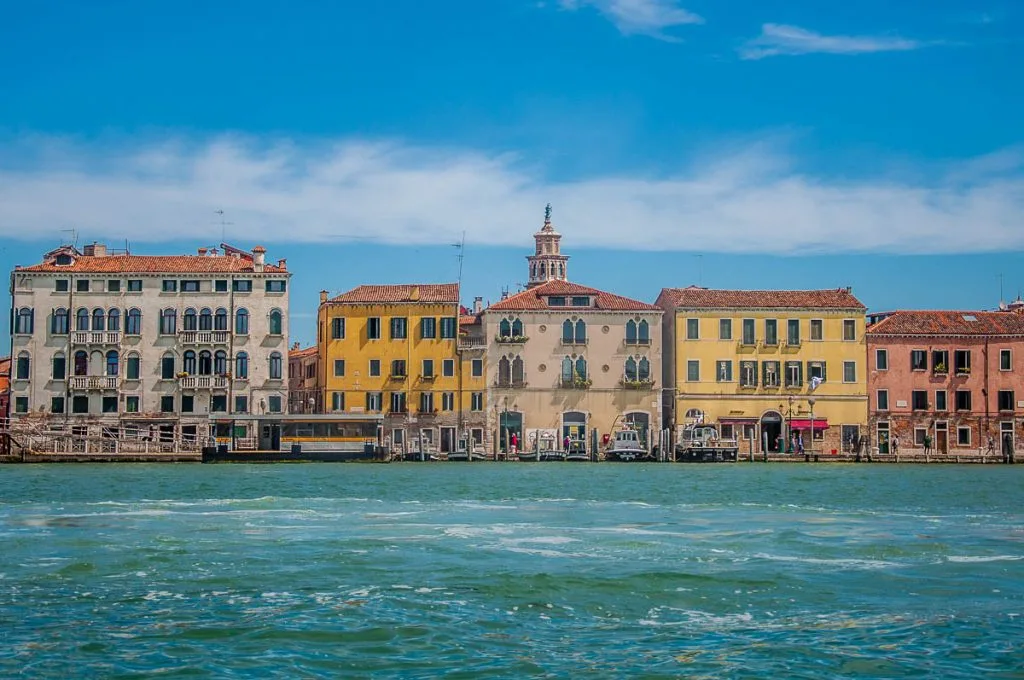
The Venetian sestiere – or neighbourhood – of Dorsoduro is where you will find some of the major landmarks of the City of Canals. Among them stand out the iconic Basilica della Salute, the Gallerie dell’Accademia with their world’s largest collection of Venetian art, and the Peggy Guggenheim Collection with its focus on the European and American art of the 20th century. In addition, dozens of art-filled churches, lesser-known museums, and hidden gems pepper this corner of Venice.
Yet, Dorsoduro still very much remains off the beaten track and preserves the authentic spirit of the city. You can feel it at places such as Campo Santa Margherita, the Squero di San Trovaso, and even the vegetable barge that moors next to the centuries-old Bridge of the Fists.
If you are planning a visit to Venice in Italy, then a day or two exploring all that Dorsoduro has to offer may end up being just your favourite memory of the City of Canals. So, in this blog post today, I shared with you the best things to do in Dorsoduro – from the main sights here to many little-known places of interest.
Maps with directions, a one-day itinerary, and a section with practical tips give you lots of helpful travel information to get you ready to explore Dorsoduro in depth.
I hope that all this will galvanise you to visit and see this Venetian sestiere for yourself.
Enjoy discovering the best of Dorsoduro!
Travel Tools
Now, Get Ready Quick for Your Trip to Dorsoduro in Venice, Italy
Consult these guidebooks.
Buy plane tickets.
Book train tickets, bus tickets or rent a car.
Research accommodation.
Select local tours and activities.
More Helpful Italy Info for You
Best of Italy: Italy Gift Guide, Italian Piazzas, Italian Markets, Accommodation for Every Budget, Best Times to Visit Italy, Italy in Summer, Italy with Kids
Italian Food: Best Italian Food Gifts, Cheap Italian Food, Rules of Italian Breakfast, Italian Breakfast Foods
Italian Coffee: Italian Coffee Culture, Italian Coffee Drinks, History of Coffee in Italy
Christmas in Italy: Fun Facts, Things to Do, Italian Nativity Scenes, Panettone, Christmas Guide
Northern Italy: Best Cities to Visit, Major Airports, Reasons to Visit
Lake Como: Things to See, Nesso
Lake Garda Towns and Villages: Best Towns, Desenzano del Garda, Riva del Garda, Malcesine, Torri del Benaco, Punta di San Vigilio, Campo di Brenzone, Borghetto and Valeggio sul Mincio
Visiting Lake Garda: Map of Lake Garda, Getting Around Lake Garda, Lake Garda with Kids, 8 Best Airports, Venice to Lake Garda, Verona to Lake Garda, Milan to Lake Garda, Bologna to Lake Garda
Verona: Things to Do in One Day, Verona Opera Festival, Day Trips from Verona, Romeo and Juliet Itinerary, Verona to Venice, Verona to Milan
Padua: Things to Do in One Day, 101 Facts About Padua, 10 Reasons to Visit Padua, Day Trips from Padua
Vicenza: Things to Do, Day Trips from Vicenza, Best Museums, The Beauty of Vicenza
Veneto: Top Places to Visit, Unique Adventures, Most Colourful Places, Mysterious Places, Most Beautiful Lakes, Reasons to Visit, Main Cities, Prettiest Small Towns, Most Beautiful Villages
Lombardy: Best Cities and Towns, Reasons to Visit, Brescia
Friuli Venezia Giulia: Venzone, Most Beautiful Villages
Emilia Romagna: Bologna, Ravenna, Comacchio, Most Beautiful Villages
Marche: Reasons to Visit, Gradara, Frasassi Caves, Temple of Valadier
Thank you for reading! Please, leave me a comment, pin the images or use the buttons right at the top and at the end of this blog post to share it on social media.
For more useful information like this, please, like my blog’s page on Facebook and subscribe to my strictly no-spam newsletter.
Pin This Blog Post!
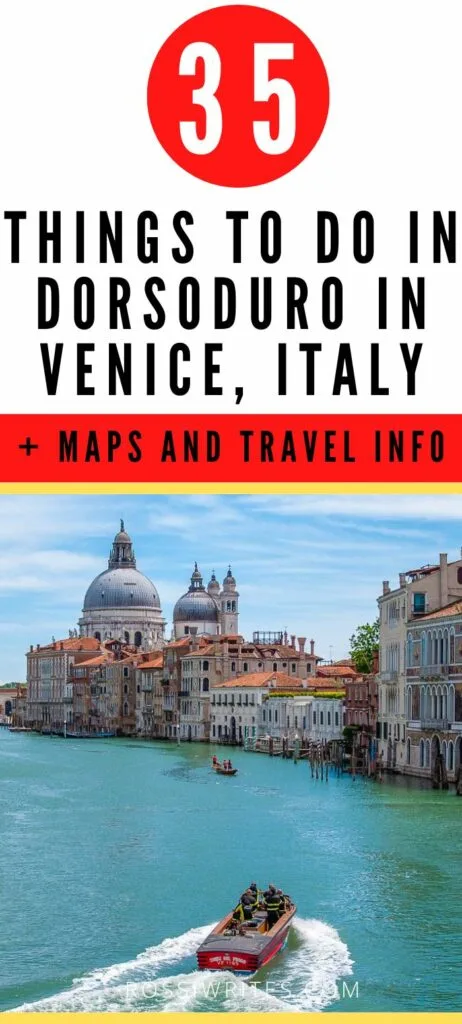
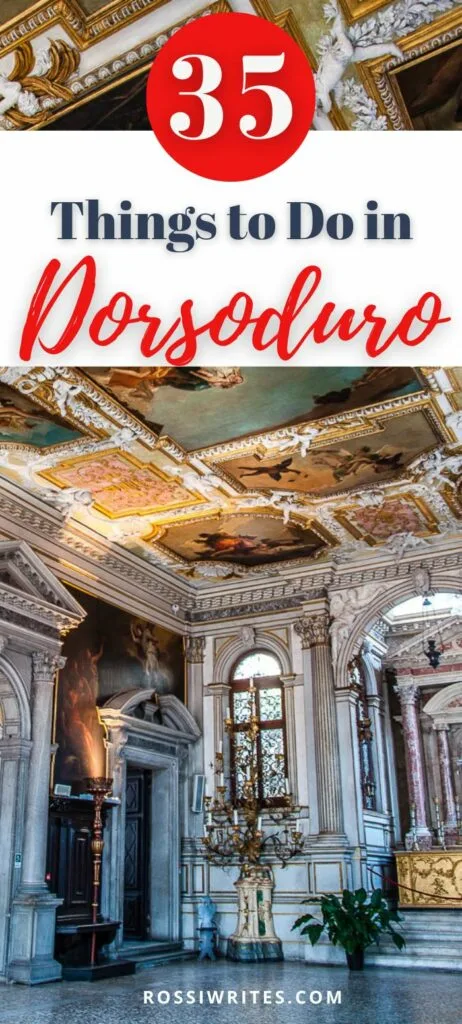

Barbara (Filatura) Bonn
Monday 26th of September 2022
Thank you for your wonderfully detailed post on Dorsoduro. The white building on the right of your first photograph, Ca' Balbi-Valier-Sammartini,(next to the Cini) is where I rented an apartment every May for many years. The curved outcropping extending over the Canal is a wonderful balcony where we had breakfast and waved at the passing gondole. I was last in Dorsoduro (in another apartment) just before the pandemic, and was sad to see how the neighborhood on "my" street, Piscina del Forner, had changed. The bakery on the corner (wonderful krapfen!) was now a takeaway sandwich shop; the butcher shop and the gastronomia were gone; the funky caffe on the corner was now a glittering tourist stop, and the shoe store that sold fake velvet gondolier slippers had disappeared. But Nico's was still there for gelato, and the restaurants on the Zattere for a relaxed lunch. I'd still go back in a heartbeat. Dorsoduro is the soul of Venice for me, and Venice is the heart of Italy.
admin
Tuesday 27th of September 2022
Dear Barbara,
Thank you for stopping by and for so beautifully sharing your memories of Dorsoduro. Your words are very inspiring! I loved the description of the palazzo's little balcony. It does look like such a special place to have breakfast on the Grand Canal! The 'touristification' of Venice is a sad reality. The shops peddling the same garish, plasticky items and the cafes selling overpriced coffee and mass-produced tiramisu and pastries make my eyes and heart hurt when I revisit Venice. Unfortunately, a similar process is happening in many popular with travellers hotspots around Italy and Europe. In Venice, however, it's painful to observe it happening as the city is so unique and special as a whole. Thank you again for stopping by!
Best wishes,
Rossi Thomson :)